LEIBNITZ, FERDINAND (1840-1875). First lieutenant and quartermaster, 39th New York Infantry, Company D. A German native, Leibnitz enlisted as a private at New York City on May 17, 1861, and mustered into Company D of the 39th New York on May 28. On October 17, 1862, he was promoted to quartermaster sergeant of his company, and then rose to quartermaster on November 21, 1863.
Civil War Bio Search
He mustered out of service on July 1, 1865, at Alexandria, Virginia. Both his pension record and an engraving on his tombstone indicate that he was a first lieutenant and quartermaster of the 39th. His last address was 112 West 25th Street in Manhattan. Leibnitz’s death was attributed to a fatty liver. In 1876, Sophie Leibnitz, applied for a widow’s pension, application 225,728, but there is no certificate number. In 1895, his name was listed in a database of The American Jew as Patriot, Soldier and Citizen, published by Simon Wolf, and is now part of an on-line compilation by Lynn Berkowitz, U.S. Civil War Jewish-American Veterans, 1861-1865. Section 114, lot 8999, grave 1199.
LEIGHTON, NATHANIEL WILSON (1833-1899). Surgeon, 173rd New York Infantry; assistant surgeon, 72nd New York Infantry. Born in Falmouth, Maine, he was a graduate of Bowdoin Medical School, joined the staff of Kings County Hospital as a physician and surgeon in 1859, and was then employed by the Eastern District Dispensary, providing medical services at no charge to the poor until 1861. On June 30, 1861, he enlisted as an assistant surgeon at Staten Island, and was commissioned into the 72nd New York’s Field and Staff on July 23. His regiment was part of the Army of the Potomac and saw heavy fighting. Leighton re-enlisted as a surgeon on September 20, 1862, at New York City, prior to his discharge from the 72nd on October 3, and was commissioned into the newly formed 173rd New York’s Field and Staff on October 10. In letters home to his wife, he wrote about the places he saw in Louisiana and described the sound of the mockingbird that he heard there for the first time.
After his discharge on November 22, 1864, Leighton resumed his medical career. From 1866 to 1885, he was an examining physician for those seeking United States pensions. Writing in support of a 50-something fellow soldier’s pension application for disability, he said, “We are all declining some 10 years before our fathers as a result of the privations of the War.” In addition to his membership in medical societies, he participated in G.A.R. activities as a member of the Mansfield Post #35 and the Henry M. Lee Post #21. His death was caused by peritonitis. Section 145, lot 23857.
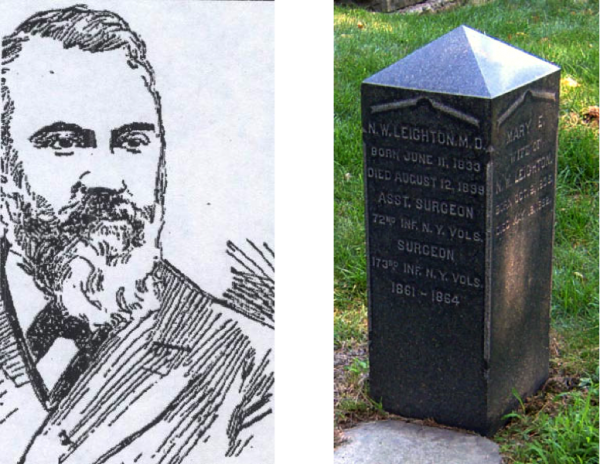
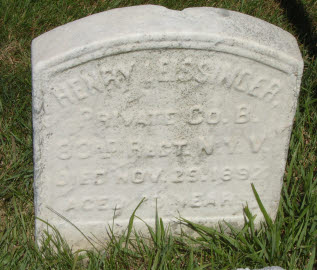
LEISSINGER, HENRY (1819-1897). Private, 83rd New York Infantry, Company B. A native of Germany, he enlisted and mustered into the 83rd New York on May 27, 1861, and mustered out on June 23, 1864, at New York City. He last lived in Brooklyn. His death was attributed to pneumonia. Section 126, lot 16874, grave 1.
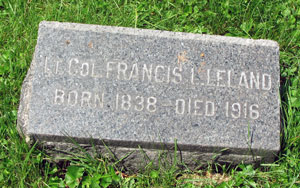
LELAND, FRANCIS L. (1838-1916). Lieutenant colonel, 1st New York Infantry, Company H; corporal, 7th Regiment, New York State Militia, Company K. Born in Argentina, he enlisted at New York City on April 17, 1861, served 30 days in the 7th Regiment, and mustered out with his company on June 3, 1861, at New York City. Enrolling again on July 29, 1861, he mustered into the 1st New York as captain on September 12, 1861, and was promoted to major at some point and then lieutenant colonel on October 9, 1862. He served in the Maryland and Peninsula Campaigns and was with the 1st New York on picket duty at Glendale and Charles City Crossroads, Virginia, when 280 men were lost, killed or wounded on June 29-30, 1862. Leland was wounded on May 2, 1863, at Chancellorsville, Virginia, and mustered out on May 25, 1863, at New York City. His last residence was in Manhattan. He died from an aneurysm. Section 79, lot 3778.
LELAND, WILLIAM W. (1821-1879). Captain and commissary, United States Volunteers, Commissary Department. A native of Landgrove, Vermont, Leland was a hotelier in New York City, first at the Astor House and then at the Clinton Hotel on Beekman Street, a popular resort. Together with his brothers, he became a proprietor of the Metropolitan Hotel in 1852. The brothers then moved to Cleveland, Ohio, where they continued in the hotel business and established a line of steamers on the lake. In the 1860s, the family expanded their business to Saratoga, New York, where they bought and refurbished the Union Hotel, and renamed it the Grand Union Hotel. The establishment, a $1,000,000 investment, was soon a well-known resort.
During the Civil War, Leland enlisted as a captain on November 16, 1861, was commissioned into the United States Volunteers Commissary Department that same date as captain and commissary, and was discharged on June 24, 1862. His obituary in The New York Times noted that his business experience in providing for thousands of people and his contacts enabled him to make many improvements as a commissary including canceling contracts for bad bread and replacing ovens with others of good quality. His obituary in the New York Herald reported that he served for a short time on the staff of General Ulysses S. Grant, who at that time commanded the Army of the West.
In an article published in The New York Times on March 16, 1870, Leland confronted George Wilkes, the writer of an article in Wilkes’ Spirit of the Times, objecting to language written against him. Although Wilkes refused to press charges, Leland struck him repeatedly over the head with his cane causing a disturbance on Broadway and Pearl Street in Manhattan. In 1873, he returned to Saratoga to manage the Grand Union Hotel and was active in promoting tourism and business there; unfortunately, the resort burned the next year. Subsequently, Leland was a broker of mining and other stocks. Leland was instrumental in promoting Saratoga as a summer resort by widening streets, planting trees and erecting an opera house. His last residence was at his cottage on Circular Street in Saratoga Springs, New York, where his New York Times obituary attributed his death to inflammation of the bowels caused by eating unripe cherries during a visit to his hometown in Vermont. Section 47, lot 6397.
LENNOX, DAVID (1831-1889). Private, 8th Regiment, New York State Militia, Company D. A New Yorker by birth, Lennox served for three months in the 8th Regiment in 1861. He last lived in Fort Hamilton, Brooklyn. His widow received a pension in 1890, certificate 318,385. he suffered from and died of heart disease. Section 15, lot 17263, grave 2201.
LENNOX, WILLIAM (1820-1873). Private, 82nd New York Infantry, Company F. Originally from Scotland, he enlisted at New York City as a private on August 14, 1862, and mustered into the 82nd on that day. Lennox was wounded at Antietam, Maryland, on September 17, 1862, and then at Gettysburg, Pennsylvania, where he was severely wounded in the left leg on July 3, 1863. Lennox was discharged for wounds on March 13, 1865, at the Ladies Home Hospital in New York City. At the time of his death, he lived at 413 Third Avenue in Manhattan. Section 17, lot 17245, grave 1724.
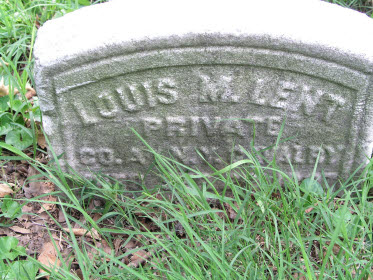
LENT, LOUIS (or LEWIS) M. (1845-1897). Private, 13th Regiment, New York State National Guard, Company H; private, 56th Regiment, New York State National Guard, Company B; private, 1st New York Cavalry, Company A. Lent served for three months in 1862, enlisting on May 28 at Brooklyn and mustering into the 13th Regiment’s National Guard on that date, and mustering out at Brooklyn on September 12. In 1863, he served 30 days with the 56th New York National Guard. He enlisted again at New York City on March 15, 1864, mustered into the 1st New York Cavalry on that date, and mustered out on June 27, 1865, at Alexandria, Virginia. As per his obituary in the New York Herald, he was a member of the Ulysses S. Grant Post #327 of the G.A.R.; comrades were invited to attend his funeral. His last residence was on 73rd Street in Bay Ridge, Brooklyn. Lent died of Bright’s disease. Olga Lent, applied from Germany for a widow’s pension in 1928; it was granted as certificate A-8-26-30. Section 114, lot 8999, grave 191.
LENTZ, THEODORE (1846-1863). Quartermaster sergeant, 15th New York Heavy Artillery, Company C. Of German birth, he was a resident of 9 Market Street in Manhattan when he enlisted as a sergeant at New York City on November 11, 1863. He immediately mustered into the 15th Heavy Artillery, was promoted to quartermaster sergeant at some point, and died of typhoid fever on September 17, 1863, at Alexandria, Virginia. Section 115, lot 13536 (Soldiers’ Lot), grave 73.

LEONARD, CHARLES HENRY (1835-1911). Lieutenant colonel and major by brevet; captain and assistant adjutant general, United States Volunteers Adjutant General’s Department; first lieutenant, 6th New York Heavy Artillery, Company F. Leonard was born in New York. After enlisting as a second lieutenant on September 7, 1862, at Yonkers, New York, he was immediately promoted to second lieutenant and adjutant before being commissioned into the Field and Staff of the 6th New York Heavy Artillery three days later. The next month, he was promoted to first lieutenant on October 29, 1862, before being discharged on November 1 of that year at Baltimore, Maryland. On December 18, 1862, he was commissioned into Company F of his old regiment, and was discharged for promotion on May 23, 1863, at which time he was promoted to captain and assistant adjutant general, and was commissioned into United States Volunteers Adjutant General’s Department.
Leonard was promoted by brevet to major on October 19, 1864, at Cold Harbor, Virginia, “for gallant and meritorious conduct during the campaign before Richmond, Virginia, and more especially in the Battles of Cold Harbor and Monocacy [Maryland], and in several engagements in the Shenandoah.” On April 2, 1865, he was promoted by brevet to lieutenant colonel “for gallantry and meritorious service before Petersburg [Virginia].” Subsequent to mustering out on January 12, 1866, he continued his military service in the United States Army from March 7, 1867 to December 31, 1870, when he resigned. In 1880, his application for an invalid pension was granted, certificate 198,179. He succumbed to angina pectoris. His remains were moved to the current location on April 25, 1912. He last lived at 36 Clark Street in Brooklyn. Section 206, lot 33619.
LEONARD, JAMES (1820-1869). Police Inspector, New York City Draft Riots. According to The Metropolitan Police, Their Services During Riot Week, Their Honorable Record by David M. Barnes, Inspector Leonard, with a force of 350 men, was ordered to relieve the inspector in charge at City Hall at midnight on July 14 during the week of the Draft Riots. Barnes reports that the mob had cut telegraph wires making communication difficult. The police force was not strong enough in any precinct to make headway against the mob necessitating the concentration of forces at Central Headquarters where Leonard took charge. His men then were dispatched to York and Leonard Streets to protect the African-Americans there and to control the gangs who were threatening them. Police were detailed to a provisions store on Greenwich Street that had been sacked, to hotels on Fulton and Cortlandt Streets whose proprietors had requested help, and to defend Brooks Brothers clothing store on Catharine Street from looters who plundered the most valuable goods, of which $5,000 worth were found later in the week squirreled away in houses in the ward. (Brooks Brothers was also a supplier of uniforms to Union soldiers; the uniforms, ironically, were notorious for poor quality.)
Toward dawn, Leonard’s forces were sent to Fulton Ferry where the mob hoped to burn Fulton Market and to prevent the landing of marines from the Navy Yard. By daylight, Leonard had to quickly gather a force to disperse mobs in the City Hall area where African-Americans were being chased and beaten, inflammatory speeches made, and the threat of further violence loomed. Later that same night, Inspector Leonard and two other officers, greatly outnumbered by the mobs, dragged away a ring-leader of the mob, as part of a ruse to disperse the gangs, and suffered the taunts and blows of the crowd. Though bloodied in hand-to-hand combat, the ruse worked and police reinforcements were sent in. Leonard was praised for being gallant, faithful, intelligent, and always there “where the fight was the hottest.”
Inspectors Leonard, George W. Dilks (see) and Daniel Carpenter commended the 2,000 member force for their actions during Riot Week, citing that all but a scant few ever “shrank from their trying duties.” Particular mention was given by author Barnes and the inspectors to the discipline and faithful service of the drill instructor, Sergeant Theron S. Copeland (see). Leonard served twenty-three years on the police force. Upon his death, he was commended for teaching and inspiring new recruits to serve the community with honor and faithful performance of duty. He was also saluted for his sense of discipline and courteous demeanor in the most trying circumstances. Members of the department attended his funeral, extended sympathy to his family and wore badges of mourning. He last lived at 455 West 22nd Street in Manhattan. He died of an aneurysm. Section 189, lot 16820.
LEONARD, JOSEPH (1819-1871). Corporal, 173rd New York Infantry, Company C. After enlisting at Brooklyn as a private on October 7, 1862, he mustered into the 173rd New York on October 30, was promoted to corporal on August 1, 1864, and mustered out on October 18, 1865, at Savannah, Georgia. His last residence was 598 Washington Avenue in Hudson City, New Jersey. Leonard died from consumption. Section 57, lot 2130.
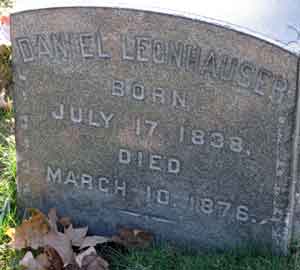
LEONHAUSER, DANIEL (1838-1876). Private, 9th Infantry, United States Army, Company E. Of German origin, Leonhauser served with the 9th Infantry of the United States Army. Further details of his military career are not available. As per the Brooklyn Directory of 1868, he was a butcher. He last lived at 601 6th Avenue in Brooklyn. His death was caused by consumption. Section 85, lot 1594, grave 280.
LeROY, ROBERT (1823-1865). Captain, United States Volunteers. LeRoy, a native of New York, was appointed assistant adjutant general of United States Volunteers with the rank of captain on September 9, 1862. When his appointment expired on March 4, 1863, he was reappointed on June 18 of that year. Brigadier General E. M. McCook, in his field report from the Chattahoochee River Railroad Bridge, Georgia, on August 7, 1864, commended him when he summarized the Atlanta Campaign by noting, “Two and a half miles of the Atlanta and West Point Railroad and telegraph destroyed near Palmetto; the same amount of Macon and Western Railroad and five miles of telegraph destroyed at Lovejoy’s Station; 1,160 wagons burned; 2,000 mules killed or disabled; 1,000 bales cotton destroyed; 1,000 sacks of corn; 300 sacks of flour, and large quantities of bacon and tobacco.” He added, “Captain LeRoy, assistant adjutant general…through all the sleepless nights, exhausting marches, and hard fighting [was] indefatigable, untiring and brave…” He last lived in Philadelphia at 1012 Spencer Street. His death was attributed to chronic diarrhea. Section 90, lot 13.
LESLIE, THOMAS JEFFERSON (1796-1874). Brigadier general, colonel and lieutenant colonel by brevet; paymaster. Born in London, England, he graduated from the United States Military Academy in 1815 (27th in his class) and served for more than 50 years as paymaster. From November 17, 1815, through July 7, 1838, he was paymaster of engineers at West Point, and also was treasurer of the Military Academy from October 31, 1817, through December 11, 1841. According to George W. Cullum, in his Biographical Register of the Officers and Graduates of the United States Military Academy, Leslie assumed increasingly higher levels of responsibility as he served in the Paymaster’s Department in New York City; New Orleans, Louisiana; St. Louis, Missouri; Charleston, South Carolina; St. Paul, Minnesota; and Washington, D.C.
During the Civil War, Leslie was chief of the Paymaster’s Department for the New York District. In 1865, he was brevetted lieutenant colonel, colonel, and brigadier general for his years of faithful and meritorious performance of duty in the pay department during the continuous period of 50 years. He retired in 1869 as a major. His last address was 30 West 128th Street in Manhattan. Section 67, lot 2919.
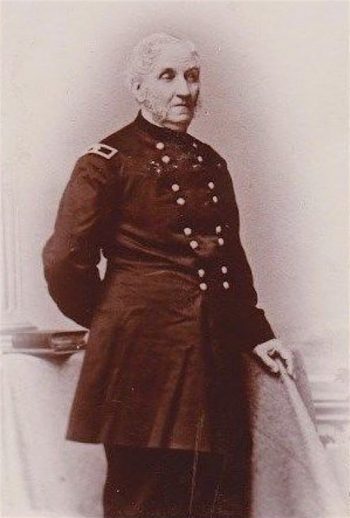

LESNARD, LOUIS (1839-1862). Private, 38th New York Infantry, Company B. A native of France, Lesnard enlisted on May 7, 1861, at New York City, and mustered into the 38th New York on June 3. He was wounded and taken prisoner on July 21, 1861, at First Bull Run, Virginia. He last lived on Spring Street in Manhattan. His death was caused by pneumonia. Section 115, lot 13536 (Soldiers’ Lot), grave 39.
LETSON, THOMAS M. (1843-1915). Private, 127th New York, Company B. A nineteen-year-old enlistee, Letson enrolled on August 14, 1862, and mustered in the next month on September 8. Other details of his military record are unspecified. His last address was in Freeport, Long Island, where he succumbed to senility. Section 2, lot 6913.
LETTS, DEWITT CLINTON (1845-1906). Corporal, 139th New York Infantry, Company C. Born in Cambridge, Vermont, he enlisted at Brooklyn as a corporal on August 21, 1862, mustered into the 139th New York on September 9, and was discharged for disability on November 1, 1862, at Camp Hamilton, Virginia. In 1900, his application for an invalid pension was granted, certificate 1,043,981. He last lived on Vine Street in Queens, New York. His death was caused by Bright’s disease. Charlotte Letts, who is interred with him, applied for and received a widow’s pension in 1908, certificate 648,894. Section 67, lot 3904, grave 1.
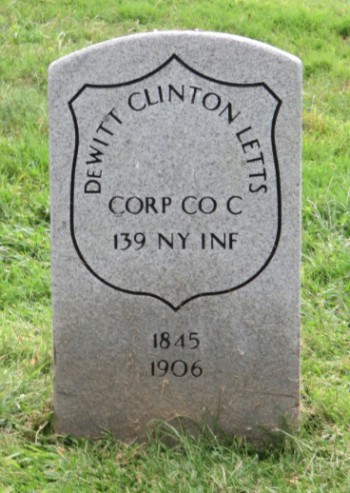

LEVICK, JAMES N. T. (1828-1868). Captain, 1st New York Infantry; private, 7th Regiment, New York State Militia, Company H. Originally from England, he became a citizen in 1859, and was living in New York City at the time of the United States census of 1860. Levick enlisted in 1861 for 30 days, mustered into the 7th Regiment, and mustered out with his company on June 3. On June 11, he entered the 1st New York as a second lieutenant, was promoted to first lieutenant on May 6, 1862, and was promoted to captain on the battlefield on April 30 of that year. He fought at these Virginia battles: Williamsburg, Seven Pines, Seven Days, Second Bull Run, Bristoe Station, Fredericksburg, and Chancellorsville. On April 30, 1863, he mustered out. Although his service in the 1st New York (Excelsior Brigade) is detailed in William Swinton’s History of the Seventh Regiment (1870), the company in which he served is not mentioned. His last residence was 11 Rivington Street in Manhattan. Section 121, lot 7639, grave 58.
LEVINE, ALEXANDER T. (1833-1891). First lieutenant, 157th Pennsylvania Infantry, Company F. Originally from Philadelphia, Pennsylvania, Levine served with the 157th Pennsylvania. According to a descendant, he was discharged on February 27, 1863. He last lived on Washington Avenue in Parkville, Long Island. His death was caused by apoplexy. His widow, Clara Levine, who is interred with him, applied for a pension, application 644,889, in 1896, but there is no certificate number. Section 135, lot 14964, grave 172.
LEWIS, ALEXANDER (1825-1866). Private, 67th New York Infantry, Company B. Lewis enlisted at Brooklyn as a private on June 20, 1861, mustered into his company the same day, and mustered out on July 7, 1864, at Brooklyn. He last lived in Flatbush, Brooklyn. Section A, lot 8100, grave 740.
LEWIS, ANDREW (1839-1862). Private, 83rd New York Infantry, Company E. Lewis enlisted at New York City on August 16, 1862, and mustered in on that date. He was killed on the battlefield at Fredericksburg, Virginia, on December 13, 1862. Section ?, lot ?.
LEWIS, HENRY WILLIAM (1836-1899). Rank unknown, United States Navy. According to a descendant, Lewis, a native of Wales, served with the Union Navy during the Civil War. No further details are known. He last resided at 84 Walcott Street, Brooklyn. He died of bronchitis. Section 205, lot 30277, grave 2.
LEWIS, JAMES ROBERT (1845-1900). Sergeant, 56th New York Infantry, Company A. A Brooklynite by birth, Lewis enlisted as a private at Newburgh, New York, on July 17, 1861, and mustered into the 56th New York on July 31. He re-enlisted on February 16, 1864, was promoted to corporal on September 1, 1864, and then to sergeant on March 27, 1865. He mustered out at Charleston, South, Carolina, on October 17, 1865.
A firefighter in civilian life, the Veterans Census of 1890 confirms Lewis’s Civil War service. As per his obituary in the Brooklyn Daily Eagle, which confirmed his service in the 56th Regiment, he was a Freemason and member of the Putnam Engine Company No. 21, Brooklyn Volunteer Fire Department; members of the 56th Regiment and the Volunteer Fire Department were invited to his funeral. His descendants report that he was a member of the G.A.R. Lewis last lived at 261 14th Street in Brooklyn. His death was attributed to valvular disease of the heart. Section 45, lot 8361, grave 4.
LEWIS, JOHN F. (1821-1874). Sergeant, 48th New York Infantry, Companies E and A. Of English birth, he enlisted as a corporal at Brooklyn on August 27, 1861, immediately mustered into Company E of the 48th New York, was reduced to ranks on an unknown date, and was promoted to corporal on July 18, 1863. He re-enlisted on December 22, 1863, was wounded on June 5, 1864, at Cold Harbor, Virginia, and was promoted to sergeant on September 21, 1864. Wounded a second time at an unknown place on January 17, 1865, he was listed as absent and wounded at the time he mustered out. During his service, he was transferred to Company A. He last lived at 483 Degraw Street in Brooklyn. His death was caused by phthisis pulmonalis. Section 115, lot 13536 (Soldiers’ Lot), grave 70.
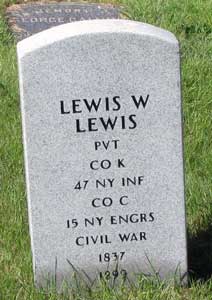
LEWIS, LEWIS W. (1837-1899). Private, 47th New York Infantry, Company K; 15th New York Engineers, Company C. Lewis, a native of Wales, enlisted at New York City on July 3, 1861. He mustered into the 47th on September 14, and deserted at the expiration of a furlough on February 15, 1864. Ten days later, he re-enlisted as a private in the 15th New York Engineers, and deserted the next month on March 11 at Washington, D.C. His last address was 366 Carroll Street in Brooklyn. His death was caused by pneumonia. Section 2, lot 5499, grave 1026.
LEWIS, MARCUS M. (1841-1894). First sergeant, 15th Infantry, United States Army, Company D. He enlisted as a first sergeant and mustered into the 15th Infantry of the Regular Army. Other details of his service are not known. He last lived at 394 Pulaski Street in Brooklyn. He succumbed to valvular disease of the heart. Section 31, lot 9723.
LEWIS, ROBERT A. (1828-1873). Private, 155th New York Infantry, Company D. Of Irish origin, Leeds enlisted as a private at New York City on September 20, 1862, mustered into his company the same day, and deserted four days later at New York City. Lewis last resided at 177 Front Street in Brooklyn. He succumbed to heart disease. Section 179, lot 11469.
LEWIS, THEODORE FRELINGHUYSEN (1827-1903). First lieutenant, 1st New York Mounted Rifles, Companies D, F, and I. A life-long New Yorker, he enlisted as a sergeant at Monticello, New York, on September 3, 1861, and mustered into Company D of the 1st Mounted Rifles fifteen days later. Lewis was promoted to first sergeant on July 8, 1862, and to first lieutenant a month later on August 13, effective upon his transfer to Company F. He resigned on April 9, 1863. Upon re-enlisting as a first lieutenant on July 4, 1863, he was commissioned into Company F of the same regiment on September 14, also served in Company I, and was dismissed on December 13, 1864. He last lived in Syosset, New York. His death was attributed to senile disability. Section 81, lot 4063.
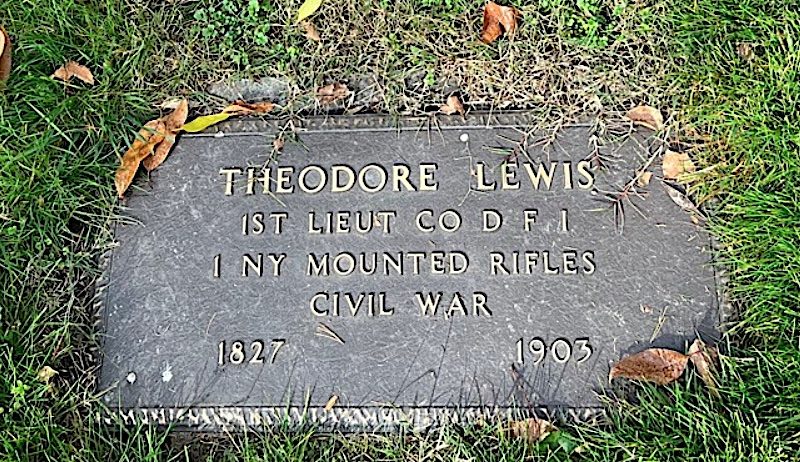

LEWIS, THOMPSON (1831-1896). Private, 7th Regiment, New York State Militia, Company H. Lewis enlisted as a private on April 17, 1861, for 30 days and mustered out on June 3. At the time of his death, he resided at 1362a Bergen Street in Brooklyn. His death was caused by erysipelas, a skin disease. His widow, M. Louise Peters, who is interred with him, applied for a pension in 1919, application 1,147,651, but there is no evidence that it was certified. Section 185, lot 18316.
LEWIS, WILLIAM C. (1826-1896). Surgeon, 82nd New York Infantry. Born in Ireland, Lewis enlisted and was commissioned into the 82nd New York’s Field and Staff on February 20, 1862, at New York City, as an assistant surgeon, and was promoted to surgeon the next month on March 25. Brigadier General Willis A. Gorman, the commanding officer at Fair Oaks, Virginia, wrote from there on June 3, 1862, about the heavy fighting on May 31, “The assiduous attention to the wounding of Dr. Lewis…merits the highest commendation.” He was discharged on July 29, 1862. His last address was 23 Decatur Street in Brooklyn. He died of nephritis. Section 145, lot 25787.
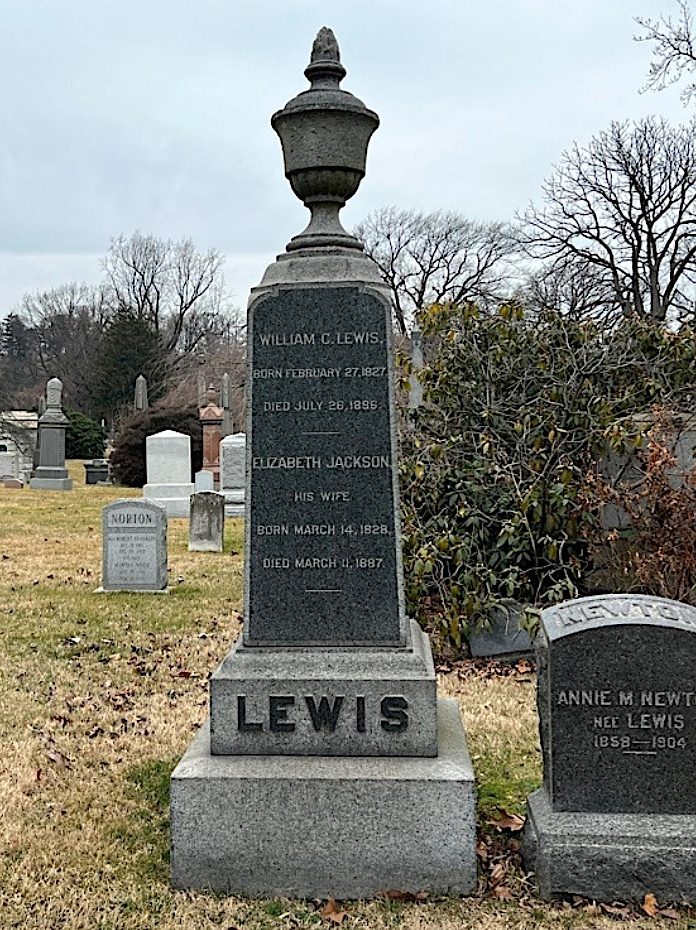
LEYDEN, JAMES (1845-1876). Private, 37th New York Infantry, Company E. After enlisting as a private at New York City on September 20, 1862, he mustered immediately into the 37th New York, and mustered out on June 22, 1863, at New York City. He died from burns at the Brooklyn Theater fire on December 5, 1876, a conflagration in which 150 people lost their lives. He last lived at 199 State Street in Brooklyn. Section 59, lot 2229, grave 31.
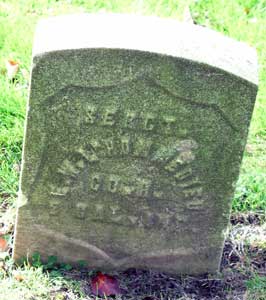
L’HOMMEDIEU, EDWARD W. (1833-1905). Sergeant, 2nd California Infantry, Company H. Born in Long Island, New York, he enlisted at San Francisco, California, on January 25, 1862, mustered into the 2nd California on December 7, 1863, and mustered out on January 25, 1865, at San Francisco. He last lived at 35 Rossuth Place in Brooklyn. Apoplexy claimed his life. Section 15, lot 7254, grave 6.
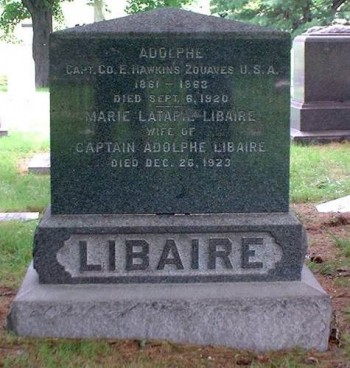
LIBAIRE, ADOLPHE (1840-1920). Medal of Honor recipient; captain, 9th New York Infantry, Company E. Born in Baccarat, France, he enlisted as a captain at New York City on April 23, 1861, and was commissioned into the 9th New York a month later on May 4. He earned the Medal of Honor for his courage at Antietam, Maryland, on September 17, 1862. His citation read, “In advance on the enemy and after his color bearer and the entire color guard of eight men had been shot down, this officer seized the regimental flag and with conspicuous gallantry carried it to the extreme front, urging the line forward.” According to Lieutenant Matthew J. Graham of the 9th Regiment, he recorded that on the morning of September 17, 1862, Colonel Edgar Addison Kimball (see) called Libaire to him and after Kimball entrusted the flag to his captain, Libaire said, “I will bring it back in safety, or you will never see my face in this world again.” After eight men fell dead or wounded carrying the flag, Graham wrote:
It seemed instant death to carry the old flag that day; but the thought of duty was greater than the thought of danger, and as the flag went down the last time, the gallant Libaire himself sprang forward in the midst of the reign of death and the horrors of hell, grasped the colors firmly in his hands, and with slashing eye and cheerful tone, cried at the top of his voice: ‘Come on boys! Come on!’ and never surrendered his hold until he had planted this American Flag upon the stone wall, the last defensive position the enemy’s infantry held, while the remnant of our regiment pressed forward and drove the enemy’s gunners from their cannon.
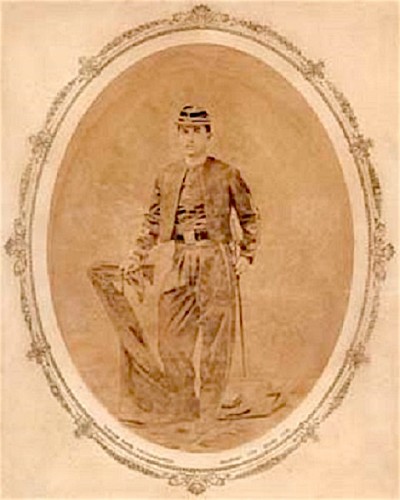
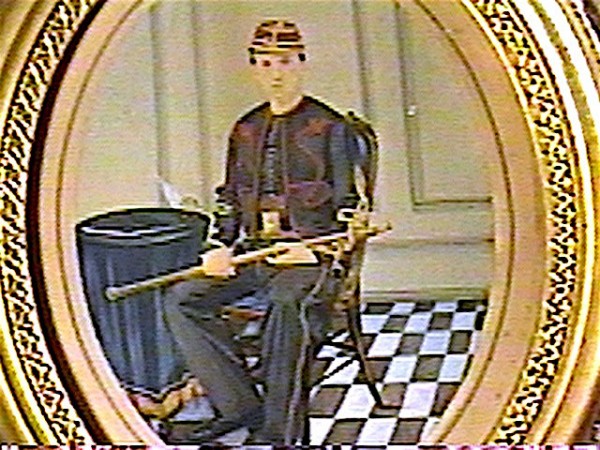
Libaire mustered out on May 20, 1863, at New York City. His tombstone identifies him as a member of Hawkins’ Zouaves, the informal name of the 9th New York. He was a member of the Edgar Addison Kimball Post #100 of the G.A.R., named for his beloved commander at Antietam. He last lived at 149 West 50th Street in Manhattan. His death was caused by carditis. Section E, lot 19638.
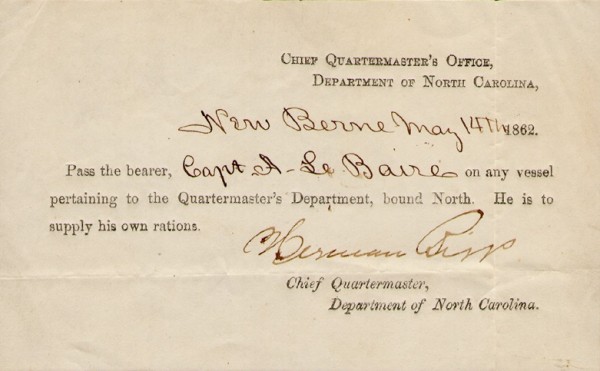
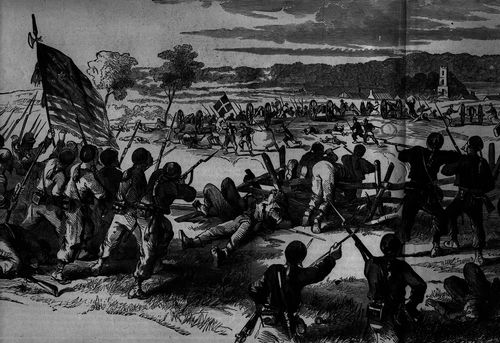
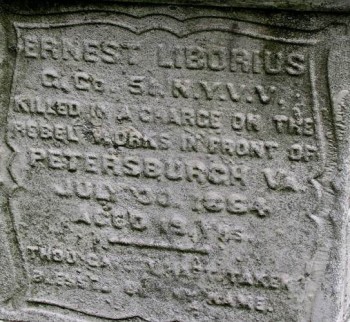
LIBORIUS (or LIBERIOUS, LABORIOUS), ERNEST R. O. (1845-1864). Private, 13th Regiment, New York State National Guard, Company E; 51st New York Infantry, Company G. A resident of 30 Chapel Street in Brooklyn, Liborious enlisted at Brooklyn on May 28, 1862, mustered into the 13th National Guard the same day, and mustered out after three months on September 12 at Brooklyn. He re-enlisted on April 12, 1864, and mustered into the 51st Infantry on that date. On July 30, 1864, he was killed at the Battle of the Crater at Petersburg, Virginia, during an assault on Confederate railways and bridges. Originally interred in the Soldiers’ Lot, on November 3, 1864, he was moved to the current location on May 4, 1865. Section K, lot 15769.
LIDDLE, JOHN B. (1840-1910). Private, 37th Regiment, New York State National Guard, Company D. According to his obituary in The New York Times, Liddle, a native of New York City, was an actor before the Civil War, appearing in the old Bowery Theatre with Charles L. Fox. Enlisting as a private at New York City on May 29, 1862, he mustered into Company D of the 37th National Guard and mustered out after three months on September 2 at New York City. Liddle was a mason, a volunteer fireman, and a trustee of the Benevolent Fund of the firemen of New York City. He successfully applied for an invalid pension in 1894, certificate 917,300. His last residence was 1723 79th Street in Brooklyn. Eliza Liddle applied for and received a widow’s pension shortly after his death from cancer in 1910, certificate 706,959. Section 201, lot 25309, grave 2.
LIESEGANG (or LISEGANG), BENJAMIN LeROY (1845-1933). Private, 13th Regiment, New York State National Guard, Company H; 1st New York Heavy Artillery, Company H; 36th New York Infantry. Born in New York City, he enlisted on May 28, 1862, at Brooklyn, mustered into the 13th that day, and mustered out on September 12, 1862. He also served in the 1st New York Heavy Artillery and the 36th New York Infantry.
Remaining active in military affairs, he was a member of the Ulysses S. Grant Post #327 of the G.A.R. According to his obituary in The New York Times, his father William (see) served as a captain who commanded a number of troop ships during the Civil War. His obituary also notes that at the time of his death he was one of few men alive to have actually heard Lincoln deliver the Gettysburg Address. In civilian life, his family business, Joseph Liesegang, was involved with stevedores on the Brooklyn pier. In 1907, he applied for and was granted an invalid pension, certificate 1,142,101. He last lived at 227 Ocean Parkway in Brooklyn. His death was caused by heart disease. Section 167, lot 18018.
LIESEGANG (or LISEGANG), WILLIAM (1812-1879). Commander of troop ships. Originally from Ramsgate, England, he became a naturalized citizen on May 14, 1838. A passport application (date unknown) described him as having auburn hair, gray eyes, large nose, round chin, oval face, large mouth, medium forehead and florid complexion. According to the 1857-1862 Brooklyn Directory, he was a shipmaster living at 17 Butler Street. The 1862, 1863 and 1865 Brooklyn Directories list him as a shipmaster living at 44 Douglass Street. An article in the Brooklyn Daily Eagle and the obituary of his son, Benjamin Liesegang (see), report that Liesegang commanded a number of troop ships during the Civil War. On April 10, 1865, the New York Herald reported that Liesegang, as commander of the USS Matanza transported 900 rebel prisoners, part of those captured by Major General William T. Sherman from Bentonville and Goldsboro, North Carolina, and Columbia, South Carolina. A captain from the 13th Connecticut and of 100 soldiers guarded the prisoners. The River Queen, President Abraham Lincoln’s boat, was at City Point, Virginia, when the Matanza departed.
As per the aforementioned news story in the Brooklyn Daily Eagle on January 9, 1867, William Liesegang was the captain of the bark Rebecca Caruana, a newly christened vessel that was built at the shipyard of C. & R. Poillon for the Messrs. Waydell & Co., shipping merchants at 162 South Street in Manhattan. That article also noted that Liesegang had 40 years of sea experience including time spent in the transport service during the Civil War. The Rebecca Caruana was destined to ply the waters from Manhattan to Matanzas, Cuba. His descendant notes that he also commanded the USS Matanza on voyages from Brooklyn to Cuba. The 1873-1876 Brooklyn Directory notes that he was a captain living at 212 Smith Street, his last address. His death certificate indicates his occupation as seaman. He was survived by his wife, Lydia née Southerton and six children; one child died in 1863 at age four.
According to his descendant, Liesegang’s niece, Elizabeth Batina Spreyer recollected a voyage in which her uncle hosted President Abraham Lincoln on one of his ships; the article appeared in the Santa Cruz [California] Evening News on February 14, 1925. Section ?, lot 33332.
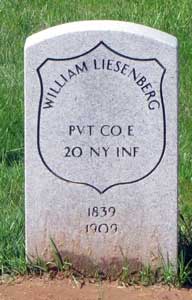
LIESENBERG, WILLIAM (1839-1909). Private, 20th New York Infantry, Company E. Of German birth, Liesenberg enlisted as a private and mustered immediately into the 20th New York on August 24, 1861. He mustered out on June 1, 1863, at New York City. His last residence was the Soldiers’ Home in Bath, New York, where he was admitted on March 26, 1900. His death was caused by stab wounds. Section 2, lot 5499, grave 756.
LIESON (or LEISON), THEODORE (1830-1898). Private, 3rd Regiment, New York State Militia Cavalry, Company C. Originally from Germany and a carpenter by trade, Lieson enlisted as a private on July 28, 1861, and mustered into the 3rd New York Militia Cavalry. He was discharged at the expiration of his three month enlistment on November 2. In 1892, his application for an invalid pension was granted under certificate 891,752. His last residence was 528 East 84th Street in Manhattan. He died of cirrhosis of the liver. Lieson’s name was listed on the Mortuary Table for 1899. Rosalia Lieson was awarded a widow’s pension, certificate 494,189. Section 134, lot 29725, grave 429.
LIGHTBODY, COLIN (1839-1868). Private, 132nd New York Infantry, Company C. A native New Yorker, Lightbody enlisted as a private at Brooklyn on August 25, 1862, mustered immediately into the 132nd New York, and deserted the next month on September 28 at New York City. He last lived in Manhattan on East 61st Street between First and Second Avenues. Phthisis was the cause of his death. Section 29, lot 11068.
LIGHTBODY, WILLIAM (1846-1905). Private, 82nd New York Infantry, Company H. On June 11, 1861, he enlisted as a private at New York City, and immediately mustered into the 82nd New York. He deserted on October 19, 1862, at Bolivar Heights, West Virginia. He may also have served as a private in the 19th Infantry, United States Army, Company A. He last lived at 10 Bedford Street in New York City. He died of nephritis. Section 44, lot 4358.
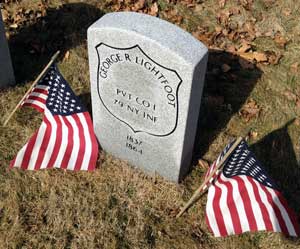
LIGHTFOOT, GEORGE R. (1837-1864). Private, 79th New York Infantry, Company I. On March 25, 1862, he enlisted at New York City, where he lived, and mustered in on that date. He died of chronic diarrhea on December 24, 1864, at Washington, D.C. Section 115, lot 13536 (Soldiers’ Lot), grave 97.
LILLISS (or LLIES), JOHN (1832-1899). Unknown rank, 14th United States Infantry, Company E. Originally from Ireland (although Green-Wood records say Canada), Lilliss served in the 14th U.S. Infantry. Further details are unknown. According to a descendant, he, William (see), and Joseph (see) were brothers. His brother-in-law, Truman Sumner (see), fought for the Confederate States of America. He last lived at 152 South 9th Street in Brooklyn. Section 168, lot 14830.
LILLISS (or LELLIS, LILLIS, LLIES), JOSEPH (1848-1894). Private, 6th New York Cavalry, Company A. A native of Montreal, Canada, he was listed as a nineteen-year-old when he enlisted as a private at New York City on April 12, 1864, and mustered into the 6th New York Cavalry that day for a term of three years. Borne on the rolls as Joseph Lellis, his muster roll indicates that he was a driver who was 5′ 5¾” tall with hazel eyes, black hair and a dark complexion. On September 12, 1864, he was admitted to Cuyler General Hospital in Germantown, Pennsylvania, suffering from chronic diarrhea and was furloughed on October 4, 1864. His muster roll notes that on October 31, 1864, he was absent and sick in hospital. Lilliss was on furlough on December 2, 1864. There are no further records about his service. He is the brother of John Lilliss (see) and William Lilliss (see). His brother-in-law, Truman Sumner (see), fought for the Confederate States of America. Section 168, lot 14830.
LILLISS (or LILLAS), WILLIAM (1840-1903). Private, 36th New York Infantry, Company F. A native of Germany (although Green-Wood records say Canada), he enlisted as a private at New York City on May 13, 1861, mustered into the 36th New York on June 19, and mustered out on July 16, 1863, at New York City, citing rheumatism. In 1890, his application for an invalid pension was approved, certificate 915,763. According to a descendant, he and John (see) and Joseph Lilliss (see) were brothers. His brother-in-law, Truman Sumner (see), fought for the Confederate States of America. He last lived at 31 West 2nd Street in Brooklyn. Section 168, lot 14830.
LILLY (or LILLEY, LILY, LIBBY), ELIAKIM (or ALICAN, BENJAMIN) (1807-1863). First sergeant, United States Marines. A native of Massachusetts, Lilly enlisted in the United States Marines in 1837, was assigned as a sergeant to the sloop St. Louis in 1842, and was assigned to Brooklyn as a sergeant in 1843. According to his 1842 enlistment papers (and all of his subsequent re-enlistment documents), he was 5′ 9½” tall with hazel eyes, brown hair and a fresh complexion. From 1850-1862, he was an orderly sergeant on the receiving ship USS North Carolina, a temporary lodging to prepare men before they were sent out to sea. A news article in the Evening Star (Washington, D.C.) on September 27, 1860, noted that Lilly was one of the men who did an experiment in New York Harbor testing what materials offered the best resistance to the new Minie balls that had just been introduced into the Marine Corps. The new weapon was the subject of another article that reported that Orderly Sergeant Lilly and others from the North Carolina tested a new pattern musket rifle at Coney Island that was superior for coastal defense.
An article in the Brooklyn Daily Eagle on March 30, 1861, noted that the North Carolina was at the Brooklyn Navy Yard where Sergeant Lilly of the marine guard was training the approximately 350 hands on board to be “perfect soldiers.” Lilly was in charge of 40 men who were the marine guard for the vessel. He re-enlisted for four years on September 29, 1862, and died at Brooklyn while still attached to the North Carolina. The 1863 Brooklyn Directory indicates that he was a seaman. As per his obituary in the Brooklyn Daily Eagle, he was a first sergeant on the North Carolina. He last lived at 23 Stanton Street in Brooklyn. Cemetery records list “congestion of the brain” as the cause of his death. Section 114, lot 8999, grave 886.
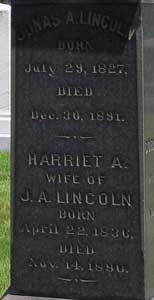
LINCOLN, JONAS A. (1827-1891). Corporal, 71st Regiment, New York Sate National Guard, Company E. Born in Wilmington, Vermont, he enlisted at New York City on June 28, 1862, mustered into the 71st Regiment that day, and mustered out on September 2 of that year at New York City. In July 1890, he attended a meeting of the Sons and Daughters of Wilmington, a reunion commemorating the 140th anniversary of America’s independence and focusing on the topic, “A Brief Account of the Measures Which Resulted in the Reunion.” Lincoln’s name and those of others who served in the Civil War were listed with their cities of residence and regiment numbers. As per his obituary in the New York Herald, he was a Freemason and member of the Veteran Corps of the 71st Regiment; members of both organizations were invited to attend his funeral. His last residence was 89 St. Mark’s Avenue in Brooklyn. He succumbed to pneumonia. Section 158, lot 17260.
LINDENSTRUTH, HENRY (1829-1875). Quartermaster, 11th Regiment, New York State National Guard. Born in Germany, he enlisted as a quartermaster on May 28, 1862, at New York City, was commissioned on that day into the Field and Staff of the 11th Regiment’s National Guard, and mustered out on September 16, 1862, at New York City. When the 11th Regiment was activated the next year, he re-enlisted, and on June 16, 1863, was commissioned again into the Field and Staff of the 11th National Guard. He mustered out on July 20, 1863, at New York City. He died at German Hospital. Section 15, lot 17263, grave 219.
LINDNER, THEODORE (1840-1901). Private, 39th New York Infantry, Company H. Born in Germany, he enlisted at New York City as a private on May 17, 1861, mustered in on May 28, and served until his discharge for disability at the Washington, D.C. Hospital on April 29, 1862. On July 3, 1901, Lindner’s name was among the 57 Brooklyn deaths listed in the New York Sun and The New York Times which were attributed to a heat wave. His last residence was at 135 21st Street, Brooklyn. His death was caused by phthisis (tuberculosis). Section D, lot 7078, grave 282.
LINDSAY, ALEXANDER (1837-1879). Private, 53rd New York Infantry, Company I. A native of New York State, Lindsay enlisted as a private on September 12, 1861, the same date he mustered into the 53rd New York. He was discharged on March 21, 1862, at Washington, D.C. His last address was in New York City. The cause of his death was phthisis. Section 17, lot 17245, grave 1761.
LINDSAY, GEORGE (1840-1928). First sergeant, 66th New York Infantry, Company F. Originally from Ireland, Lindsay enlisted as a private at New York City on September 14, 1861, and mustered into Company F of the 66th New York on November 4. As per his muster roll, he was a car-man who was 5′ 9″ tall with gray eyes, brown hair and a florid complexion. His muster roll notes that he distinguished himself by good behavior and courage in action at the Battle of Antietam, Maryland, on September 17, 1862. In addition, he distinguished himself at the Battle of Gettysburg, Pennsylvania, on July 2, 1863, when he seized the colors and saved it. On July 7, 1863, he was promoted to corporal for bravery. Subsequently, he was promoted to sergeant on November 1, 1863, and to first sergeant on November 20, 1864. Lindsay mustered out at New York City on August 30, 1865. In 1890, his application for an invalid pension was granted, certificate 908,913. He last lived on Railroad Avenue in Hackensack, New Jersey. He died from chronic myocarditis. Section 17, lot 17245, grave 945.
LINDSAY, JOHN (1816-1866). Private, 119th New York Infantry, Company A. Born in Scotland, he enlisted at New York City as a private for three years of service on July 31, 1862. He mustered in on September 4, and was listed as absent and sick dating from October 17, 1864, including the muster-out of his company. His last address was 138 8th Avenue in Manhattan. Apoplexy claimed his life. Section 50, lot 11345.

LINDSAY, THOMAS W. (1823-1896). Corporal, 84th New York (14th Brooklyn) Infantry, Company C. Lindsay enlisted as a private at Brooklyn on August 22, 1862, and mustered into the 14th Brooklyn on that date. He was discharged upon his promotion to corporal on January 14, 1864. His death was attributed to hemiplegia, a paralysis of half the body. Section 199, lot 29313.
LININGTON, THEODORE (1840-1910). Private, 13th Regiment, New York State Militia, Companies C and F. Linington served for three months in 1861 with the 13th Regiment. In 1891, his application for an invalid pension was granted, certificate 1,071,158. He last resided at 1900 Benson Avenue in Brooklyn. He died of acute indigestion. In 1917, his widow, Emma Rose Linington, received a pension, certificate 874,911. Section 112, lot 15818.

LINN (or LIN), JOHN M. (1836-1906). Private, 8th Regiment, New York State National Guard, Company F. Of Scottish birth, Linn enlisted as a private at New York City on May 28, 1862, mustered immediately into the 8th Regiment, and mustered out with his comrades on September 10, 1862. In 1897, his application for an invalid pension was approved under certificate 958,739. The 1900 census reports that he was married and living in Manhattan. He last lived at 330 West 9th Street in Manhattan. His death was caused by locomotor ataxia (inability to control one’s bodily movements, resulting in non-fluid walking). Shortly after his death in 1906, Henrietta Linn applied for and received a widow’s pension, certificate 635,792. Section 86, lot 2205, grave 46.
LINN (or LYNN), VALENTINE (1839-1915). Bugler, 5th Regiment, New York State National Guard, Company A. A native of Germany, Linn enlisted for 30 days in 1863 and served as a bugler in the 5th New York National Guard. As per his obituary in the Brooklyn Daily Eagle, he was a well-known carriage maker who later manufactured automobile bodies; he was listed as a carriage-maker in the 1868 Brooklyn Directory. For forty-nine years, his factory was located at 47-53 Bergen Street in Brooklyn. In addition, he was a Freemason and member of the Brooklyn Quartette Club; members of both organizations were invited to attend his funeral. His last residence was 8205 19th Avenue in Brooklyn. Linn succumbed to nephritis. Section 195, lot 26947, graves 1 and 2.

LINNEKIN, THOMAS J. (1833-1904). Captain, United States Navy. Born in Boothbay, Maine, his father was a soldier in the War of 1812. He grew up with a love of the sea and at the outbreak of the Civil War was commander of a schooner, the Protector, which was captured by a Confederate privateer on July 28, 1861. After being taken prisoner at New Berne, North Carolina, he turned down numerous offers to join the Confederate Navy as a blockade runner. He escaped from a Confederate guard on August 4, 1861, took to sea in a rowboat and was picked up by the USS Savannah off the coast of North Carolina. Before returning to active duty, he was debriefed at Washington, D.C.; this led to vital information on Confederate blockade running.
Linnekin was commissioned as acting master in the United States Navy on August 16, 1861, and took command of the USS Connecticut serving as its sailing master and coast pilot. On November 28, 1862, he commanded the USS Currituck and took part in the Fredericksburg, Virginia, engagement with the shore batteries on the Rappahannock River on December 10-12, 1862. On May 13, 1863, he led an expedition in Virginia to Tappahannock for the purpose of destroying a large amount of Confederate stores. On June 13, 1863, he was in charge of the transport and covered the landing of General Kilpatrick’s Cavalry on the Rappahannock River. During the invasion of Pennsylvania by General Lee’s Army of Northern Virginia, he was protecting the ferry crossing from Confederate raids.
Later, Linnekin was at the helm of the USS Currituck which kept open the only lines of communications between Washington, D.C., and New York City. After this action, he was placed in charge of the receiving ship USS Ohio traveling between Boston, Massachusetts, and New York. On November 8, 1863, he was appointed to active duty and moved to New Orleans, Louisiana, where he was in command of the gun boat Tallahatchie on Lakes Pontchartrain and Maurepas with authority of the area from New Orleans to the Mississippi Sound. On March 21, 1865, he was ordered to convoy transports with 15,000 troops up the Fish River, Alabama, where his vessel was made the flag-ship of the invasion. Both General Canby and Admiral Thatcher were on board this ship. Subsequently dispatched to the Spanish Fort at Mobile Bay, Alabama, he was under fire for nearly three weeks. He was at the capture of Mobile Bay and was again placed in command to escort some 20,000 troops up the Alabama River to Selma. On July 10, 1865, he captained the USS Fearnot, his last command. He was honorably discharged from the Navy, with a special letter of thanks from the Navy Department on December 9, 1865. In addition to piloting gunboats, he broke up a ring of pirates in the Gulf, and rescued a Catholic priest about to be hung as a spy who mistakenly slipped through Confederate lines.
After the Civil War, Linnekin served as a pilot on a fireboat but was removed from that post in 1886, an action that he continued to contest in court. He then was a ship broker on South Street in Manhattan. Taking an active role in President Grant’s funeral, he formed a relief guard at Mt. McGregor, New York, and accompanied the body to Albany, City Hall and Riverside Park. His last address was 484 Jefferson Avenue in Brooklyn. His death was caused by nephritis. Section 23, lot 8776, grave 5.
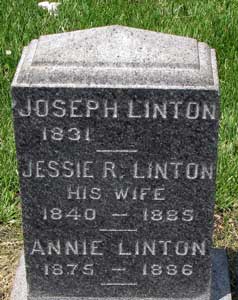
LINTON, JOSEPH (1831-1919). Private, 8th Infantry, United States Army, Companies H and D. Linton, who was born in Ireland, enlisted at New York City on an unknown date and mustered into Company H of the 8th Infantry, U.S. Army. He was transferred to Company D before he mustered out. In 1891, he applied for and was granted an invalid pension, certificate 847,689. His last residence was 660 McDonough Street in Brooklyn. He died from heart disease. Section A, lot 14838, grave 22.
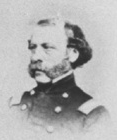
LIPPITT (or LEPPITT), FRANCIS JAMES (1812-1902). Brigadier general by brevet; colonel, 2nd California Infantry. Born in Providence, Rhode Island, Lippitt was an 1830 graduate of Brown and a lawyer and author by profession. He was commissioned captain of the 1st New York’s Company G on August 1, 1846, and was part of the force that invaded Alta California, Mexico that year. In 1847, he was commander of the force that guarded Santa Barbara, California, then mustered out on September 8, 1848. Remaining in the West after the Mexican War, he was San Francisco’s representative at the California Constitutional Convention in 1849 and was elected lieutenant governor of the newly organized state.
During the Civil War, Lippitt enlisted at San Francisco, California, on August 23, 1861, at age 49, and was commissioned into the Field and Staff of the 2nd California Infantry on September 2 as its colonel. He was placed in command of the Humboldt Military District from January 9, 1862, through July 13, 1863. Brigadier General G. Wright, commanding officer, wrote in his field report of April 18, 1862, that Lippitt, “an energetic and zealous officer,” was assigned to maintain peace with the Indians in the District of the Humboldt (Carson City to Pyramid Lake), an area where the geography was also a challenge. Wright reiterated his concern about maintaining a safe environment at Fort Humboldt on June 12 of that year citing that although Lippitt commanded ten infantry companies and one cavalry company, marauding Indians posed a problem to women and children in the area since many men went to the mines. On July 20, 1863, he was at residential headquarters at Benicia Barracks until August 11, 1864, when he was transferred to Fort Miller in Fresno, California. He returned to the Presidio at San Francisco on October 9, 1864, and mustered out there two days later. On March 13, 1865, he was brevetted brigadier general of United States Volunteers “for faithful and meritorious services.”
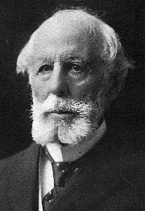
Lippitt’s experiences in the Mexican and Civil Wars formed the basis for four books that he authored: A Treatise on the Tactical Use of the Three Arms, Infantry, Artillery, and Cavalry (1865); A Treatise on Entrenchments (1866); The Special Operations of War: Comprising the Forcing and Defence of Defiles; the Forcing and Defence of Rivers in Retreat; the Attack and Defence of Open Towns and Villages; the Conduct of Detachments for Special Purposes; and Notes on Tactical Operations in Sieges (1868); and Field Service in War: Comprising Marches, Camps and Cantonments, Outposts, Convoys, Reconnaissances, Foraging, and Notes on Logistics (1869). At the time of the census of 1880, he was living in Washington, D.C. In 1902, his autobiography, Reminiscences of Francis J. Lippitt, was published. He died of senile debility in Washington, D.C. Section 24, lot 4143.
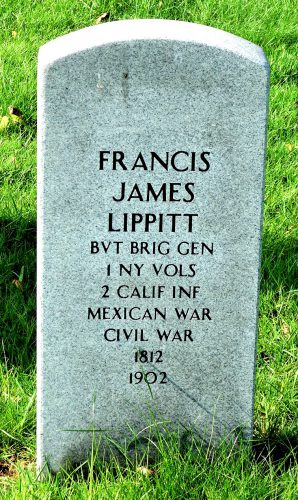
LISCOMB, WILLIAM H. F. (1844-1891). Private, 145th New York Infantry, Company F; 150th New York Infantry, Company E. First serving in the 145th New York, Liscomb enlisted as a private on August 27, 1862, and mustered into the 145th New York on September 11. On December 9, 1863, he transferred into the 150th New York. He last resided in Brooklyn. His death was caused by paralysis. Section 59, lot 743, grave 21.
LITTLE, DAVID (1846-1905). Private, 29th Iowa Infantry, Company E; 20th Iowa Infantry, Company C; 1st Regiment, United States Artillery, Company D, Regular Army. A native of Canada, Little enlisted as a private on December 27, 1864, and mustered into the 29th Iowa Infantry. His pension index card shows that he also served as a private in the 1st Regiment, United States Artillery, Regular Army, and in Company C of the 20th Iowa Infantry. When he mustered into the Frank Head Post #16 of the G.A.R. on November 27, 1883, he noted that he was a farmer who lived in Fort Hamilton Harbor in Brooklyn. In 1898, Little’s application for an invalid pension was approved, certificate 1,063,466. He last lived on 72nd Street and Third Avenue in Brooklyn. His death was attributed to nephritis. Elizabeth Little, who is interred with him, applied for and received a widow’s pension, certificate 607,749. Section 85, lot 3667, grave 36.
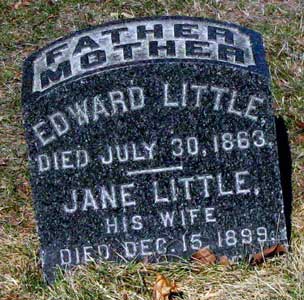
LITTLE, EDWARD (1826-1863). Private, 3rd New York Light Artillery, Battery A. After enlisting as a private at New York City on May 21, 1861, Little mustered into the 3rd New York Light Artillery on June 17. According to his muster roll, he was absent and hospitalized at Craney Island, Virginia, in February 1863, and was discharged for disability on April 5, 1863, at Fort Monroe, Virginia. In 1890, Jane Little, who is interred with him, applied for and received a widow’s pension under certificate 336,233. Section 115, lot 4196.

LITTLE, JAMES LAWRENCE (1836-1885). Surgeon-in-charge of the Park Barracks, volunteer Civil War surgeon. A Brooklynite by birth, Little was an 1860 graduate of the College of Physicians and Surgeons. He was associated with New York Hospital from 1860-1862 then became the surgeon-in-charge of the Park Barracks in 1862 at City Hall Park. He was responsible for introducing plaster of Paris splints to the United States in 1861; this procedure was used to treat fractures. Little’s paper on the use of plaster of Paris was widely circulated by the Sanitary Commission, a group advocating better hygiene and treatment for soldiers at the front and in hospitals during the Civil War.
A Republican, he was opposed to slavery and wrote articles expressing his political views. Little himself answered the call for help during the War and was at the temporary hospital at Washington, D.C., and then in the field at White House on the Pamunkey River from 1862-1863. In 1864, he helped establish the New York State Board of Health. This was a result of his work as an inspector for sanitary reform in New York City in the spring of 1864 at the behest of the Citizens’ Association. He wrote a report on conditions in the Twenty-first Sanitary Inspection District that was submitted to the Council of Hygiene of the Citizens’ Association.
Dr. Little then returned to the College of Physicians and Surgeons where he lectured on the treatment of fractures from 1864-1868. During his medical career, he was also a non-resident professor at the University of Vermont from 1875-1885, a professor of clinical surgery at the University of the City of New York in 1880, an attending surgeon at St. Luke’s and St. Vincent’s Hospitals in New York City and the Northwestern Dispensary, and a professor of surgery from 1882-1885 at the New York Post-Graduate Medical School, an institution of which he was one of the founders. Dr. Little was a member of numerous medical societies, among them the American Medical Association, the New York State Medical Society, the New York Academy of Medicine, the County Medical Society, the Medical Journal Association and the Pathological Society. Among the many medical papers that he wrote were articles related to surgery of bladder punctures, excision of the lower jaw, tracheotomy after croup, aneurisms, and restoration of lips. He also wrote A Modification of Lister’s Antiseptic Dressing in 1881. His death was attributed to peritonitis after a burst appendix. Section 120, lot 6277.
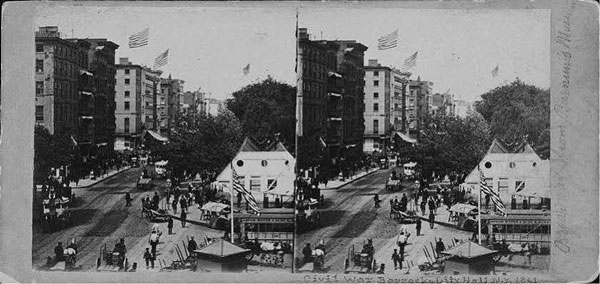
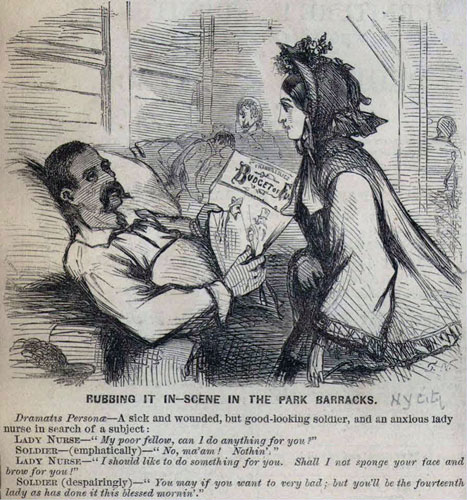

LIUERSTERMAN, LOUIS V. (?-?). Rank unknown, 103rd New York Infantry, Company D. Liuersterman’s service is marked on his gravestone in the Soldiers’ Lot, an area in Green-Wood set aside for Civil War veterans. Further details are not known. Section 115, lot 13536 (Soldiers’ Lot), grave 82.
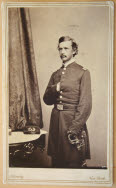
LIVINGSTON, FRANK (or FRANCIS) S. (1840-1868). Either: First lieutenant, 15th New York Engineers, Companies C and A; or, private, 10th New York Infantry, Company I. Livingston, who is interred in the Soldiers’ Lot, either served in the 15th New York Engineers or the 10th New York Infantry. If he served in the 15th, he enlisted as a first lieutenant on November 11, 1862, at Washington, D.C., was immediately commissioned into Company C of the 15th, was transferred to Company A on June 18, 1863, and mustered out on January 17, 1865. If he was the Francis Livingston who served in the 10th New York, he enlisted at Brooklyn as a private on April 26, 1861, mustered in the next month on May 2, and apparently deserted on May 15, 1861. He died of consumption at St. Luke’s Hospital in New York City. Section 115, lot 13536 (Soldiers’ Lot), grave 110.
LIVINGSTON, GEORGE BARCLAY (1834-1890). Acting volunteer lieutenant, United States Navy. A native of New York, Livingston entered the Navy as an acting master on June 8, 1861, and rose to acting volunteer lieutenant on August 30, 1864. He remained in the service after the Civil War becoming an ensign on March 12, 1868, a master on December 18 of that year, a lieutenant on March 2, 1870, and a lieutenant commander on February 4, 1882. He last lived at 505 Fifth Avenue in Manhattan. He died of heart disease. Section 100, lot 84.

LIVINGSTON, JOHN WILLIAM (1804-1885). Commodore, United States Navy. The son of Navy surgeon, Dr. William Trask, his mother was from the Livingston family. After marrying a cousin from his maternal side, he assumed the Livingston name through an act of the legislature. A New Yorker by birth, he became a midshipman at the age of 19, and entered the U.S. Navy on March 4, 1823. By 1827, he was on the sloop Warren in the Mediterranean Squadron. Livingston was commissioned a lieutenant on June 21, 1832. Subsequently, his duties engaged him in the pirate wars in the West Indies and Sumatra. Livingston served as an executive officer aboard the Congress off the coasts of California and Mexico during the Mexican War. Commissioned a commander on May 24, 1855, he rose to captain in 1861. He was placed in charge of the steamer Penguin at the start of the Civil War, and later commanded the frigate Cumberland in the James River blockade. Commissioned commodore on July 16, 1862, he was in charge of the navy yard at Norfolk, Virginia, after the Confederate evacuation, and was transferred in 1865 to the naval station at Mound City, Illinois. He retired as a rear admiral in 1868. Livingston’s last address was 22 West 50th Street in Manhattan. His death was caused by cerebro thrombosis. Section 58, lot 1036.
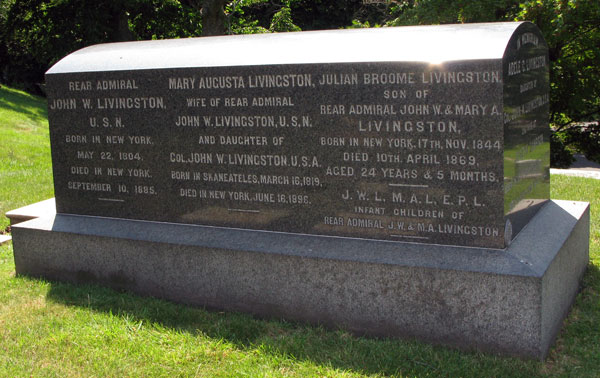
LLOYD, JAMES (1825-1869). Private, 25th New York Infantry, Company D. A native of New York City, Lloyd enlisted there as a private on August 31, 1861, and mustered immediately into the 25th New York. Further details of his service are unknown. His last residence was in New York. His death was caused by brain disease. Section 164, lot 16901.
LLOYD, WALTER M. (1832-1870). Captain, 174th New York Infantry, Company G. He enlisted as a captain at New York City on October 17, 1862, mustered into the 174th that same day, and was discharged on December 22, 1862. According to William Swinton’s History of the Seventh Regiment (1876), Lloyd served in Company H of that unit; the dates of that service are not noted. His last address was in Brooklyn. He died from a hemorrhage. Section 36, lot 11462.
LOCK, GEORGE (1839-1892). Sergeant, 139th New York Infantry, Companies A, H and I. After enlisting as a private on August 21, 1862, he mustered into the 139th New York the next month on September 9, and mustered out on June 19, 1865, at Richmond, Virginia. He last resided at 1000 Fulton Street in Brooklyn. After his death, caused by enteritis (inflammation of the intestine), Catherine Lock applied for and received a widow’s pension, certificate 361,234, as did his granddaughter, Katherine Sherman, in 1894, certificate 426,002. Section 103, lot 7808.
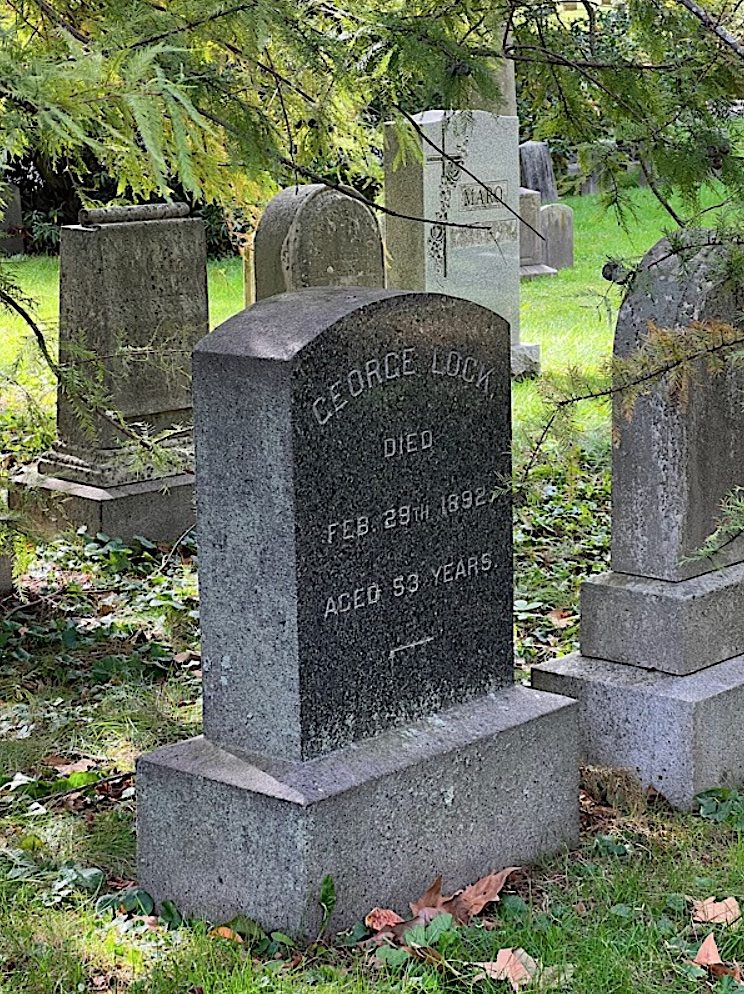
LOCKARD (or LOCKHARD, LOCKHARDT), GEORGE WASHINGTON (1843-1922). Private, 67th New York Infantry, Company G; drummer, 71st Regiment, New York State Militia. As per his obituary in the Brooklyn Daily Eagle, Lockard was born on Bond Street in Brooklyn and was a lifetime resident of the borough. The 1860 census reports that he lived in Brooklyn with his parents and younger sister. His obituary notes that he was a drummer for the 71st Regiment during the Civil War. According to his soldier records, he enlisted as a private at Brooklyn on May 27, 1861, mustered into Company G of the 67th New York on June 20, and mustered out on July 4, 1864. Lockard’s obituary indicates that after the Civil War, he was a member of the company organized by the Reverend Henry Ward Beecher (see) in the old 13th Regiment. On August 11, 1866, he applied for and received an invalid pension, certificate 73,172. As per the 1870 census, he lived in Brooklyn with his wife and infant daughter. Lockard was a member of the 18th Street Methodist Episcopal Church and then helped organize, with his wife, the Borough Park Congregational Church. At the time of his death, he was a widower survived by two daughters and three sons. Section 129, lot 27373, grave 37.

LOCKE, AUGUSTUS D. (1845-1904). Sergeant, 11th Maine Infantry, Company K. A resident of Stetson, Maine, Locke stood 6’½” tall with a high forehead, straight nose, dark brown hair and ruddy complexion. He enlisted at Stetson, Maine, as a private on November 2, 1861, mustered immediately into the 11th Maine, was detailed to artillery service in 1863, and was promoted to corporal at some point in 1863. He re-enlisted on January 16, 1864, was wounded in action at Drewry’s Bluff, Virginia, on May 16, 1864, and received a promotion to sergeant in 1865. Locke was named on the list of casualties (killed or wounded) at Appomattox, Virginia, dated April 9, 1865. He was discharged for disability on July 6, 1865. Two months later, on September 7, 1865, he applied for an invalid pension that was granted, certificate 56,869. According to his obituary in the New York Herald, he was a member of the Royal Arcanum. His last residence was 221 West 34th Street in Manhattan. He died from a hemorrhage. His widow was granted a pension, certificate 842,927. Section 52, lot 3929.
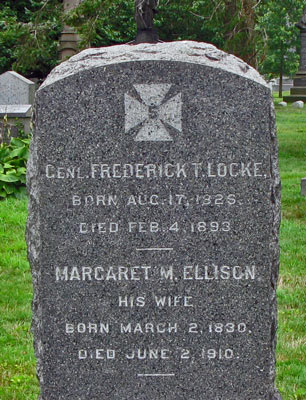
LOCKE, FREDERICK THOMAS (1826-1893). Brigadier general and colonel by brevet; lieutenant colonel and assistant adjutant, United States Volunteers; adjutant, 12th New York Infantry. Born in New York, Locke enlisted there as an adjutant on April 19, 1861, was commissioned into the Field and Staff of the 12th New York on May 2, was detailed to the 8th Brigade, Martinsburg, Virginia, on July 14, and mustered out on August 5 of that year at New York City. Subsequently he was promoted to captain and assistant adjutant of volunteers in September 1861. Locke served as chief of staff to Major General Fitz John Porter (see). He was promoted to lieutenant colonel and assistant adjutant general on August 20, 1862, and held that position until after the Civil War. He was brevetted to colonel on August 1, 1864, and to brigadier general of volunteers for his action at Five Forks, Virginia, and his War service on April 1, 1865.
In civilian life, Locke was a plumbing contractor. In 1885, he read a paper to the New York State Commandery recollecting his battlefield experiences, “Many of my companions will remember the operations of the army just preceding and during the battle of the second Bull Run, in August, 1862. Owing to frequent changes in the position of the troops, consequent upon the impolite and persistent contiguity of the enemy, and the rapid marches from one place to another, the army fared badly. Owing to the absence of trains and the scarcity of rations, forage, and medical supplies, much suffering was occasioned to man and beast.”
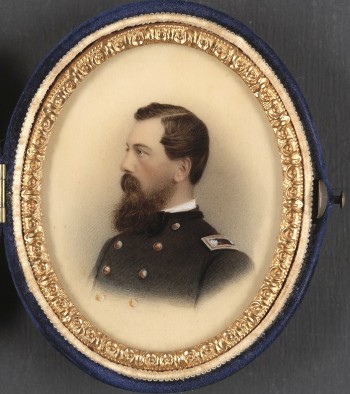
He went on to recount that he later learned that Major General Pope gave an order to destroy the stores and medical supplies at the depot at Bristoe Station, Virginia, and read that report. In summation, he said, “…I look back upon my military career with pride and thankfulness that I was permitted to serve my country in her hour of need, and to be of some use in maintaining the integrity of our glorious Union.” He last lived at 203 West 46th Street in Manhattan. His Tiffany presentation sword, with the inscription, “Presented to Lieut. Col. Frederick Locke U.S.V. / by the Officers of the old 12th and other friends / February 28th 1863,” sold at auction in 2004. Section 152, lot 19380.
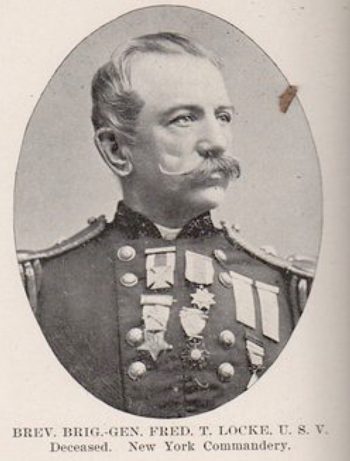
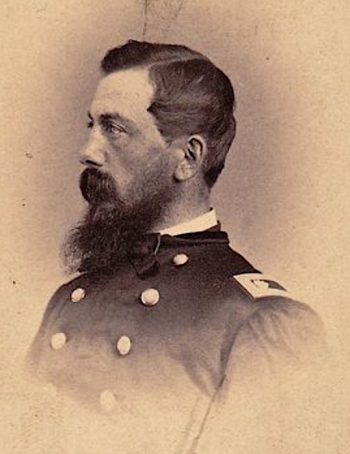
LOCKITT, THOMAS (1830-1865 or 1830-1887). First lieutenant, 53rd New York Infantry, Company A. There are two Thomas Lockitts, both born circa 1830, who were buried at Green-Wood. There is only one soldier history for a Thomas Lockitt who was a Union soldier. Lockitt enlisted at New York City on March 3, 1862, as a first lieutenant, and on March 22 was commissioned into the 53rd New York Infantry. He was discharged on September 13, 1862, when the regiment was consolidated with the 132nd New York. The Thomas Lockitt who died in 1865 last lived on Fulton Avenue in Brooklyn; he died from typhus. That man is buried in section K, lot 13268. The Thomas Lockitt who died in 1887 was born in England and became a naturalized citizen in Kings County on July 11, 1870. As per the 1880 census, he was a salesman in a pork store. He last lived at 136 Nostrand Avenue in Brooklyn. His death was attributed to cirrhosis. That man is buried in section 121, lot 11189, grave 205.
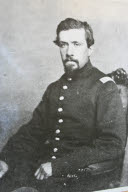
LOCKMAN, ISAAC P. (1832-1884). Colonel by brevet; lieutenant colonel, 119th New York Infantry, Company K; first lieutenant, 83rd New York Infantry, Company H. A native of New York City, 5′ 7¼”, of fair complexion and hair with grey eyes, Lockman enlisted there as a sergeant on May 27, 1861, and mustered into the 83rd New York on that day. He was promoted to first lieutenant on November 27, 1861. The same month he contracted malaria and intermittent fever at Muddy Branch, Maryland, where his regiment was stationed to guard the Potomac Canal and the railroad between Harpers Ferry, Virginia, and the Monocacy River. He returned to New York City on leave for treatment. After recovering, he rejoined the regiment but suffered another bout of malaria in June 1862 and was discharged on June 24, 1862. After treatment and recovery at New York City he re-enlisted as a captain there on August 30, 1862, and was commissioned into Company K of the 119th New York the next month on September 10. In June 1863, he again suffered intermittent fever, and was treated at Washington, D.C., rejoining his regiment at Frederick City, Maryland, in July 1863. He rose to the rank of major on March 9, 1864, to lieutenant colonel on May 15, 1864, but suffered recurrent illness and was transferred to Field and Staff ten days later at Warrenton, Virginia, as a result of his inability to perform field duty. He again required treatment, catching up with his regiment in June at Kolb’s Farm, Georgia. On June 7, 1865, he mustered out at Bladensburg, Maryland. He was brevetted to colonel of United States Volunteers on May 18, 1866, “for gallant and meritorious services.”
After the Civil War, Lockman resumed his work as a plate printer. He applied for an invalid pension in 1879, application 271,971, citing long-term disability as a result of the malaria he contracted during his military service. It was not granted. Despite his personal physicians’ affidavits to the contrary, the Pension Board’s examining physicians concluded his symptoms were syphilitic and not malarial, and disabilities “prolonged or aggravated by vicious habits” were not compensated. His case was hindered by the fact that no records from his regiment prior to April 1863 were on file. He repeatedly re-applied, citing increasing disability. In 1879, he enlisted the aid of his congressman, who sent a personal note to the Commissioner of Pensions, to no avail. In June 1880, a bill was introduced in Congress H.R. 5451 requesting that he be granted a pension. Apparently it did not pass, as in April 1884 another bill H.R. 6477 was introduced for the same purpose. However, at the time of his death from phthisis (tuberculosis) in September, Lockman had still not received a pension. He last resided at 442 West 43rd Street in Manhattan. Section 13, lot 9198.
LOCKWOOD, ISRAEL ROBERT (1842-1902). First sergeant, 1st Michigan Cavalry, Companies K, E, and A. A native of New York, Lockwood was a farm laborer living in Romulus, Michigan, at the time of the 1860 census. During the Civil War, he enlisted as a private at Trenton, Michigan, on August 22, 1861, and mustered into Company K of the 1st Michigan Cavalry on September 26. He was promoted to first sergeant on June 17, 1863. According to a descendant, Lockwood fought at numerous engagements including the Battle of Gettysburg, Pennsylvania. He re-enlisted on December 21, 1863, at Stevensburg, Virginia, transferred intra-regimentally to Company E on March 6, 1864, and was reduced to ranks on October 31, 1864. His discharge papers indicate that he was transferred to Company A on December 9, 1864. He was discharged on August 11, 1865, at Fort Leavenworth, Kansas. The census of 1870 reports that he was living in Nankin, Michigan, and doing railroad work; he was married with two daughters. He was a jewelry salesman living in Brooklyn with his wife and three children as per the 1892 New York State census. As per his obituary, he last lived at 827 Monroe Street in Brooklyn. Adeline Lockwood applied for and received a widow’s pension of $8.00 per month that was granted in 1902, certificate 561,731. Section 136, lot 28307, grave 810.
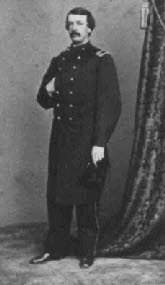
LOCKWOOD, JOHN B. (1831-1912). Major and additional paymaster, United States Volunteers Paymaster’s Department. Lockwood, who was born in New York State, enlisted as a major and was commissioned into his unit of the United States Volunteers Paymaster’s Department on February 21, 1863, with an immediate promotion to major and additional paymaster. He resigned on August 5, 1865. In civilian life, he was a clerk in the New York Custom House for nearly 50 years. In 1904, he received a pension, certificate 1,095,078. Lockwood last lived at 816 Eighth Avenue in Brooklyn. He died of a cerebral hemorrhage. Section 51, lot 11993.
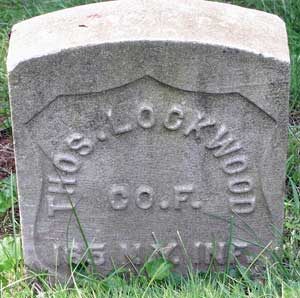
LOCKWOOD, THOMAS L. (1846-1917). Private, 165th New York Infantry, Company F. A native of Oyster Bay, Long Island, he enlisted and mustered into the 165th New York on January 15, 1864. On September 1, 1865, he mustered out at Charleston, South Carolina. He last lived on Lexington Avenue in Manhattan. Lockwood succumbed to arteriosclerosis. Section 206, lot 21347, grave 448.
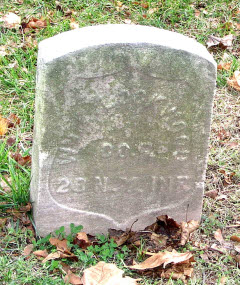
LOCKWOOD, WILLIAM E. (1847-1911). Private, 28th Regiment, New York State National Guard, Company C or F. Born in New York City, Lockwood enlisted and served in the 28th Regiment for 100 days in 1864. His government-issued gravestone, circa 1900, confirms his service in the 28th. His last residence was 358 West 48th Street in Brooklyn. He died of heart disease. Section 114, lot 8999, grave 1392.
LOCKWOOD, WILLIAM LEWIS (1837-1867). Captain, 48th New York Infantry, Company H. Before the Civil War, Lockwood was a founding member of Sigma Chi fraternity at Miami University in Oxford, Ohio. After he enlisted as a first lieutenant on June 24, 1861, at New York City, he was commissioned into the 48th two months later on August 26, and promoted to captain on June 18, 1862. On July 18, 1863, he was wounded in battle at Fort Wagner, South Carolina, and was discharged on May 26, 1864. His three granddaughters unveiled a granite monument that bears his name at Green-Wood Cemetery on November 27, 1932. Section 171, lot 12355.
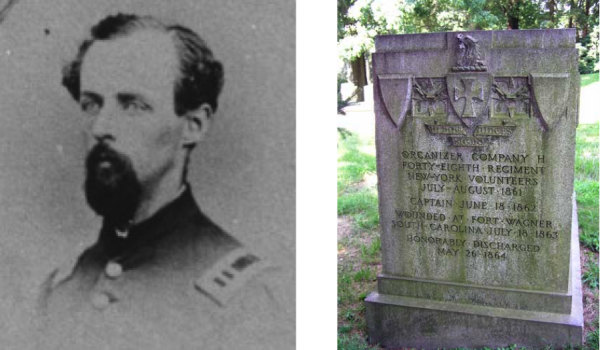
LODER, BENJAMIN (1836-1905). Sergeant, 7th Regiment, New York State Militia, Company H. A native of New York City, Loder enlisted as a private on April 26, 1861, mustered into Company H of the 7th Regiment, and mustered out with his company on June 3. When the 7th Regiment was reactivated in 1862 and was part of the New York State National Guard, Loder returned to his company as a sergeant on May 25, 1862, and mustered out with his comrades on September 5. He returned again to the 7th Regiment in 1863 and served for 30 days, mustering out as a sergeant on July 20, although one document states that he was a corporal during that enrollment.
As per the 1880 census, Loder was living in Brooklyn and working as a clerk in a railroad office; the 1889 New York City Directory states that he was a public accountant at 5 Cotton Exchange who resided at 319 Macon Street in Brooklyn. On December 21, 1894, he mustered into Marquis de Lafayette Post #140 of the G.A.R. In 1904, he applied for and received a pension, certificate 1,089,802. At the time of his death from pulmonary atelectasis (lung collapse), he still lived at 319 Macon Street. He left property of less than $1,000. Section 55, lot 6450.
LOEBER, CHARLES W. (1832-1912). Private, 27th Regiment, New York State National Guard, Company H. Of German birth, Loeber served in the 27th New York National Guard in 1863. He last resided at 150 Court Street in Brooklyn. He died of heart disease. Section 87, lot 1715, grave 268.
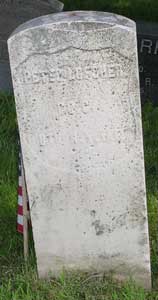
LOECHER, PETER (1836-1895). Private, 8th New York Infantry, Company G. Originally from Germany, he enlisted on April 23, 1861, at New York City, and mustered in that day. He was discharged for disability at Roach’s Mills, Virginia, on September 5, 1861. His last address was 573 First Avenue in Manhattan. Section 135, lot 14964, grave 441.
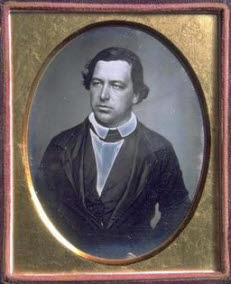
LOESER, LUCIEN (1818-1897). Lieutenant colonel, 7th West Virginia Cavalry. A native of Orwigsburg, Pennsylvania, he attended the Moravian school in Littitz. Loeser was graduated from the United States Military Academy at West Point in 1842, number 26 in his class. He then embarked on his military career in the United States Army after being brevetted to second lieutenant of the Second Artillery on July 1 of that year. Rising through the ranks, he was promoted to second lieutenant of the 3rd Artillery on May 31, 1845 and to first lieutenant on March 3, 1847. He was detailed to California and on one mission was the official bearer of gold nuggets that were discovered in 1848 at Sutter’s Mill that ushered the famous Gold Rush. Loeser took the precious metal by ship to Panama, across the isthmus on horseback, by ship to New Orleans, and then overland to Washington, D.C., where it was presented to President Polk who announced the discovery in a formal declaration to Congress. He was aboard the San Francisco in December 1853 when the vessel was shipwrecked off Delaware Capes during a storm as the vessel sailed for California via Cape Horn. Loeser and his family were rescued by the Kirby and transferred to the Lucy Thompson for the trip back to New York. He was promoted to regimental adjutant from March 1-April 4, 1854, and then promoted to captain on November 11, 1856. He tendered his resignation on December 3, 1858.
Returning to service during the Civil War, Loeser enlisted as a lieutenant colonel on November 27, 1861, was commissioned into the Field and Staff of the 8th Virginia (Union) (which later became the 7th West Virginia Cavalry) that same day. An experienced officer, he helped train troops that the loyal Governor of Virginia, Francis Pierpoint, had mustered. He was dismissed on August 24, 1862, when he became ill and was no longer able to remain in the field. Loeser then served as chief clerk in the Quartermaster’s office in New York City through the end of the War until 1873. Subsequently, he was appointed clerk and then chief of the record department at the Custom House, a position he held for 24 years, from 1873-1897. He last lived at 401 Pacific Street in Brooklyn. His death was due to nephritis. Section 178, lot 12109, graves 8 and 9.
LONG, JAMES (1845-1896). Sergeant, 84th New York (14th Brooklyn) Infantry, Company G; 5th New York Veteran Infantry, Company J. Long enlisted at Brooklyn on May 18, 1861, as a private, and mustered into the 14th Brooklyn on May 23. He was promoted to corporal on an unknown date, then to sergeant on January 8, 1864. On June 2, 1864, he was transferred to the 5th New York Veterans serving with that unit until he mustered out on July 2, 1864, at Camp Parole, Petersburg, Virginia. Long played on the 14th Brooklyn’s baseball team. His last residence was 65th Street, near 6th Avenue in Brooklyn. Phthisis was the cause of his death. Section 135, lot 14964, grave 891.
LONG, JOHN H. (1828-1882). Chief engineer, United States Navy. Born in England, Long first entered the Navy as a third assistant engineer on November 6, 1849, and resigned the next year on November 5. He returned to serve during the Civil War as a first assistant engineer on June 15, 1861, and became a chief engineer on November 10, 1863. He last lived in Long Island City, Queens and he died of “miasma.” Section 1, lot 7875.
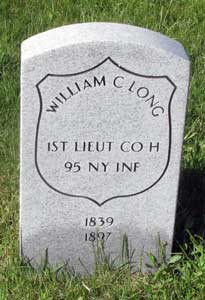
LONG, WILLIAM C. (1839-1897). First lieutenant, 95th New York Infantry, Company H. Born in Ireland, he enlisted at New York City as a first sergeant on November 4, 1861, and mustered in four days later. He was promoted to first lieutenant on March 31, 1863, and dismissed on July 8, 1864. He last lived at 13 Delancey Street in Manhattan. He succumbed to heart disease. Section 17, lot 17245, grave 296.
LONGSTREET, AARON B. (1822-1877). Private, 29th New Jersey Infantry, Company E. A native of New Jersey, Longstreet enlisted there as a private on September 3, 1862, mustered into Company E of the 29th New Jersey on September 20, and mustered out at Freehold, New Jersey, on July 6, 1863. He died at St. Luke’s Hospital in Manhattan of a fractured skull. Section 50, lot 9702.
LORCK, HERMAN (or JOHN) C. (1846-1911). Private, 23rd Regiment, New York State National Guard, Company I; landsman, United States Navy. Lorck was born in New Jersey. As per the 1860 census, Lorck was a 14-year-old errand boy living in the Third Ward of Brooklyn. During the Civil War, he first served as a private in the 23rd Regiment, Company I. He then enlisted as a landsman in the United States Navy and served aboard the USS Vermont and the USS Union.
The 1880 Brooklyn Directory indicates that he was in the fish business at the corner of Henry and Orange Streets in Brooklyn Heights and living at 71 Tillary Street. The 1891-1896 Brooklyn Directories list him as working in the fish business. The 1890 Veterans Census confirms his service in the 23rd National Guard. The 1904 Brooklyn Directory states that he was a salesman living at 1134 57th Street in Brooklyn. He died at the Long Island College Hospital after an accident in which he was thrown from his employer’s horse-drawn wagon; he was employed as a fish dealer. At the time of his death, he had $1,000 equity in his 57th Street home. According to his obituary in the Brooklyn Daily Eagle, he was a member of the Methodist Episcopal Church in Borough Park and was a Freemason. Agnes Lorck, who is interred with him, applied for a widow’s pension in 1911, application 972,998, but it was not certified. His pension index card indicates that he also used the alias John Lorck. Agnes Lorck applied to the War Department for a headstone for her husband’s gravesite on May 10, 1930; the stone was shipped to her from Lee, Massachusetts, on July 28, 1930. Section 206, lot 21347, grave 120.

LORD, BOWEN G. (1820-1870). Captain of Sanitary Squad, Metropolitan Police Department, New York City Draft Riots. A native of Maine, Lord was a captain of the Sanitary Squad of the New York City Police Force as of 1859. The Sanitary Police, together with Board of Surgeons, inspected tenements, enforced school children’s truancy laws, examined steam boilers and licensed people qualified to run steam engines, and dealt with nuisance issues on the streets.
However, according to David Barnes in The Metropolitan Police, Their Services During Riot Week, Their Honorable Record, the routines of the Sanitary Squad were broken during the mayhem of the Draft Riots. On July 13, 1863, they were called to Printing House Square and were held in reserve during the night. On July 14, Captain Lord and his company were called to Prince and Crosby Streets to prevent rioters from burning an African-American church. They then were sent to the Union Steam Works on 22nd Street and Second Avenue, where, upon the orders of Inspector George W. Dilks (see), they joined other policemen in entering the factory, going up the stairs, and disarming the rioters of the carbines they were using as clubs. Lord then aided Inspector Daniel Carpenter, one hundred and fifty police and a detachment of military to patrol the Seventeenth Ward. On July 15, a portion of the Sanitary Squad was sent to Harlem where rioters were firing on the houses of African-Americans at 122nd Street while Lord and others were sent to take charge of the 16th Precinct. His first act was to deputize 150 citizens as special policemen, who, with the police, would patrol the precinct. His team was vigilant; there was only one arson fire in their jurisdiction and that was quickly put out by the Fire Department. Lord remained with the 16th Precinct until July 18th when his squad took over the protection of the Central Office until July 27th. Author Barnes was generous in his praise of Lord, “Capt. Lord, ever zealous and possessing moral courage which is infectious, incited his men, and was emulated by them, to a full performance of duty…”
As per his obituary in The New York Times, Lord was always associated with the enforcement of health laws during his fifteen years as a police officer. He last lived at 335 West 20th Street in Manhattan. He died of carcinoma peritoneum. Section 174, lot 17456.
LORD, GEORGE DeFORREST (1833-1892). First lieutenant, 22nd Regiment, New York State National Guard, Company G. Serving for three months in 1862, he enlisted at New York City on May 28, was commissioned into the 22nd Regiment’s National Guard, and mustered out at New York City on September 5. His last address was 3 West 35th Street in Manhattan. His death was caused by septicemia, a blood poisoning. Section 171, lot 12977.
LORD, JAMES (1819-1895). Sergeant, 47th New York Infantry, Company E. A native of Brooklyn, he enlisted at New York City on June 15, 1861, mustered into the 47th on September 14 of that year, was promoted to sergeant during his service, and mustered out at an unknown place and date. He last lived at 417 Van Brunt Street in Brooklyn. “Rupture of the heart” is listed as the cause of his death. Section 4, lot 21316, grave 79.
LORD, THOMAS (1835-1899). Major by brevet; captain, United States Volunteers Aide-De-Camp; first lieutenant, 7th Regiment, New York State Militia, Company K; second lieutenant, 1st New York Infantry, Company G. Lord enlisted at New York City as a first sergeant on April 17, 1861, and mustered into the 7th Regiment on April 26, mustering out after 30 days on June 3. When the 7th was reactivated a year later and part of the National Guard, he was promoted to first lieutenant on May 25, 1862, and commissioned into his unit with that rank. He mustered out on September 5, 1862, at New York City. A promotion to second lieutenant followed on November 15, 1862, when he was commissioned into the 1st New York Infantry. On December 2, 1862, he was discharged from his company upon being promoted to captain and commissioned on that date into the United States Volunteers Aide-De-Camp where he served on Major General John Dix’s staff until July 1865. He was brevetted to major on March 13, 1865, “for meritorious services to date from July 7, 1864.” In July 1865, he was an assistant adjutant general on the staff of General Hooker serving until he mustered out on October 31, 1865. After the War, he lived in New York City. His death was caused by apoplexy. Section M, lot 19105.
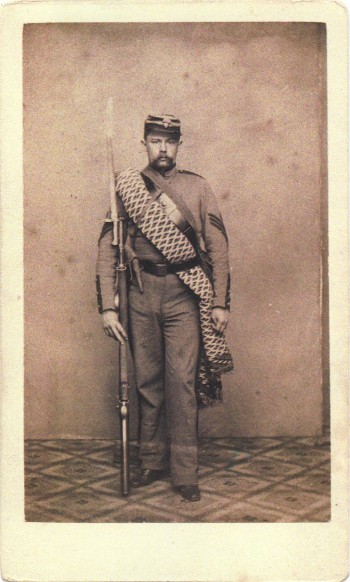
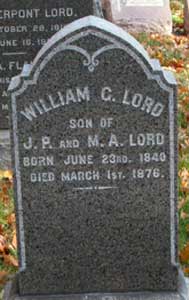
LORD, WILLIAM G. (1840-1876). Private, 13th Regiment, New York State National Guard, Company G. Lord enlisted at Brooklyn as a private on May 28, 1862, mustered into his company the same day, and mustered out on September 12 of that year at Brooklyn. He last resided at 65 1st Place in Brooklyn. Section 71, lot 850.
LOSKAM (or LOOKAMM), JOHN HENRY (1846-1923). Private, 6th Ohio Infantry, Company G. On April 20, 1861, Loskam enlisted and mustered as a private into the 6th Ohio Infantry from which he mustered out on June 6, 1861. He apparently re-enlisted because his military record shows that he had three additional years of service in the 6th Ohio. In 1883, his pension application was approved, certificate 618,019.
According to the census of 1890, he was working as a lumberman. An article in the local Newtown Register on June 1, 1905, reported that members of the Robert J. Marks Post #560 of the G.A.R., of which he was a member, decorated graves on Memorial Day at Mount Olivet Cemetery in Queens; Loskam was listed among the surviving veterans who attended the ceremony at the Soldiers’ Monument there. As per his obituary in the Newtown Register, which confirmed his Civil War service and G.A.R. membership, he also was a founding member of the Eureka Lodge of the Independent Order of Odd Fellows. The 1920 census shows that he was a homeowner living in Queens, New York, where his last residence was 38 Fisk Avenue in Maspeth. He died of broncho pneumonia. In 1925, Charlotte Loskam, his widow, filed for and was granted a pension, certificate 934,294. Section 107, lot 12650.
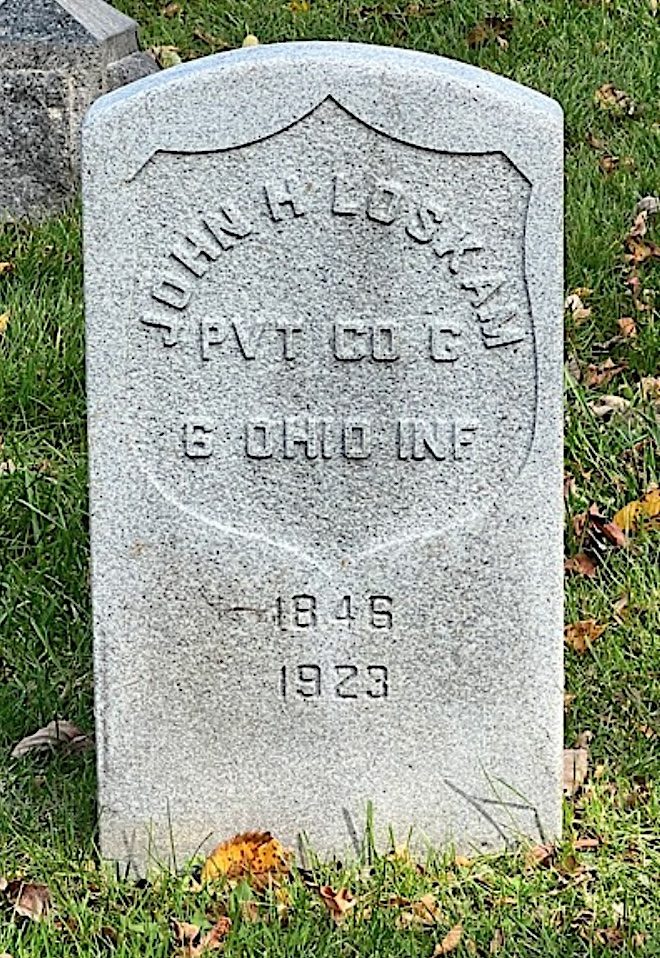
LOTT, JEROME (1814-1872). First lieutenant and adjutant, 178th New York Infantry; first lieutenant, New York Federal Guard. Born in Long Island, Lott enlisted at New York City on November 19, 1862, was commissioned in two days later as a first lieutenant with the Field and Staff of the New York Federal Guard, and was discharged after its consolidation with the 178th New York. He mustered into the 178th as a quartermaster, was promoted to first lieutenant and adjutant, and resigned his commission on January 21, 1863. He resided in College Place, New York, at the time of his death from heart disease. Section 5, lot 7120.
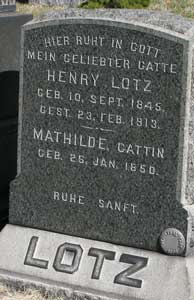
LOTZ (or LUTZ), HENRY (1845-1913). First sergeant, 187th New York Infantry, Companies B and F. Lotz, who was born in Germany, enlisted as a private at Buffalo, New York, on April 13, 1865, and mustered into Company B of the 187th New York the next day. He was promoted to first sergeant and transferred into Company F at some point before being mustered out on July 1, 1865, at Arlington Heights, Virginia. His last address was 8 Gouverneur Place, Bronx, New York. Lotz succumbed to pneumonia. Section 137, lot 29651, grave 3.
LOTZ, MARTIN (1833-1898). Private, 4th Regiment, New York State National Guard, Company C. Originally from Melsungen Hassen, Germany, Lotz immigrated to the United States in 1846 and became a naturalized citizen in 1849. During the Civil War, Lotz enlisted as a private on June 20, 1863, served for 30 days in the 4th New York’s National Guard’s Heavy Artillery, and mustered out on July 24, 1863. He served in the National Guard for about 18 years, being promoted to second lieutenant in October 1878, with rank from November 14, 1872, and leaving as a first lieutenant.
In civilian life, Lotz was a butcher. The Veterans Census of 1890 confirms his Civil War service. On July 11, 1894, he mustered into Samuel F. Dupont Post #187 of the G.A.R. Lotz belonged to many fraternal lodges and was the proprietor of a real estate business and a meat establishment. He last lived at 167 East 107th Street in Manhattan. Section L, lot 21011, grave 5.
LOUD (or LOWD, LORD, LOND), RICHARD (or RICK) E. (1842-1882). Private, 5th New York Infantry, Company B. He was born in Germany. The 1860 census, which spells his surname name “Lowd,” reports that he lived with his family in New York City and was employed as a clerk. During the Civil War, Loud enlisted as a private at New York City on July 21, 1861, and mustered into the 5th New York on July 29. He was discharged for disability on June 4, 1862, at Annapolis, Maryland. His muster roll, which notes his date of discharge, also indicates that he was listed as a deserter from Rockville on September 11, 1862, and absent without leave– that information is not correct because he later received an invalid pension; pensions were not awarded to deserters. On December 12, 1862, his application for an invalid pension was approved, certificate 282,092.
At the time of the 1870 census, which identified him as Rick Lord, he lived with his wife in New York City, worked as an engine builder and had a personal estate that was valued at $500. Loud was listed as a painter in the 1874 New York City Directory. The 1880 census, which listed him as Richard Lond, indicates that he lived with his wife, children, parents and extended family at 205 East 29th Street in New York City; he was employed as a carriage painter. He last lived in Pollyhanna, Pennsylvania. His death was attributed to apoplexy. Section 2, lot 5499, grave 364.
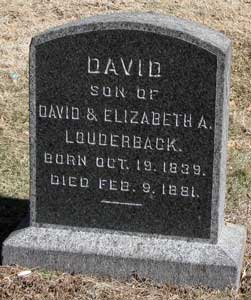
LOUDERBACK, JR., DAVID (1839-1881). Private, 7th Regiment, New York State National Guard, Company G. Louderback, a native of New York, enlisted as a private at New York City on May 25, 1862, mustered into his company that day, and mustered out three months later on September 5 at New York City. His death was caused by cancer. Section 26, lot 3898.
LOUNSBERRY, JAMES SMITH (1824-1900). Private, 9th New York Infantry, Company G; 3rd New York Infantry, Company I. On August 22, 1862, Lounsberry, a native of New York City, enlisted there as a private and mustered into the 9th New York the same day. On May 6, 1863, he was transferred into Company I of the 3rd New York. His last residence was 346 South Broad Street in Elizabeth, New Jersey. His death was attributed to edema of the lungs. Section 162, lot 14516, graves 7 and 8.
LOUNSBERY, JAMES H. (1836-1875). Captain, 5th New York Infantry, Company K. Born in Connecticut, Lounsbery enlisted at New York City on April 25, 1862, as a first sergeant, and mustered into the 5th New York on May 9. He was promoted to first lieutenant on September 6, 1861, and to captain on September 30, 1862. On May 14, 1863, he mustered out at New York City.
Lounsbery became an associate of Charles Pratt, a pioneer in the petroleum industry, whose company became part of John D. Rockefeller’s Standard Oil in 1874, and who was the founder and endower of the Pratt Institute in Brooklyn. In 1874, Lounsbery commissioned the architect Ebenezer Roberts to begin construction on a double brownstone that still stands today at 321 Clinton Avenue, Brooklyn, between Lafayette and DeKalb Avenues and which incorporates aspects of both the Italianate and Neo-Greco styles. He didn’t live to see the completion of the project as he died of Bright’s disease. His last residence was 193 Lefferts Place, Brooklyn. Section F, lot 21845.
LOVE, JAMES (1844-1874). Unknown soldier history. Love’s name appears on the Sons of Union Veterans list confirming his service in the Civil War. It is likely that he may be one of these two men. A native of Brooklyn, he may be the Love enlisted there as a private and mustered that day into the 8th Regiment, New York State National Guard. After three months, he mustered out on September 10, 1862, at New York City. Or, he may be the James Love who enlisted as a private at Brooklyn on August 25, 1862, and mustered into Company H of the 139th New York on September 9. On July 12, 1864, he was promoted to the rank of corporal in his company. He was wounded in action at the Battle of Chaffin’s Farm, Virginia, on September 29, 1864, and mustered out of service on June 19, 1865, at Richmond, Virginia. He last lived in New York City. He died of pyaemia, a type of blood disease. Section 122, lot 17806, grave 279.
LOVE, JOHN (1839-1889). Private, 48th New York Infantry, Companies B and C. Love enlisted at Brooklyn as a private on September 3, 1861, and mustered two days later into Company B of the 48th New York. He was wounded and taken prisoner at Fort Wagner, South Carolina, on July 18, 1863, and paroled the same day. After re-enlisting on January 20, 1864, he was transferred to Company C at some point, and mustered out at New York City on August 26, 1865. He was a member of the George C. Strong Post #534 of the G.A.R. in Brooklyn. He last resided at 344 Franklin Avenue, Brooklyn. He died of Bright’s disease. Section 62, lot 17565.

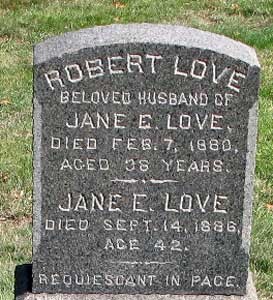
LOVE, ROBERT (1841-1880). Private, 163rd New York Infantry, Company A; 73rd New York Infantry, Company G. An Irish native, Love enlisted at Brooklyn on August 30, 1862, as a private. On October 10, 1862, he mustered into the 163rd New York where he served until his transfer into the 73rd New York on January 18, 1863. He deserted at Falmouth, Virginia, on June 1, 1863. His last residence was 135 High Street, Brooklyn. His death was caused by phthisis. Section 141, lot 25627.
LOVE, SAMUEL A. (1839-1904). Private, 13th Regiment, New York State Militia, Company D. Born in Brooklyn, Love served for three months in 1861 with the 13th Regiment. According to his obituary in the Brooklyn Daily Eagle, he was a member of the New York Fire Department, Engine 105; members of the New York Fire Department Benevolent Association were invited to attend his funeral. He last resided at 95 Rockwell Place in Brooklyn. Bright’s disease was the cause of his death. In 1905, his widow, Mary A. Love, who is interred with him, applied for and received a pension, certificate 593,003. Section 206, lot 21347, grave 482.
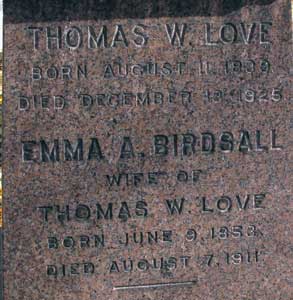
LOVE, THOMAS W. (1839-1925). Private, 71st Regiment, New York State Militia, Company A. A New York City native, Love enlisted on April 19, 1861, served with the 71st Regiment for three months, and mustered out with his company on July 30. In 1902, he applied for and received a pension, certificate 1,076,801. He last lived at the Old Soldiers Home in Kearny, New Jersey. He died from chronic myocarditis. Section 2, lot 6826.
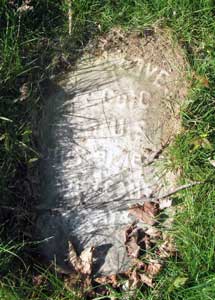
LOVE, WILLIAM A. (1839-1895). Private, 12th United States Infantry, Company C. Love served as a private in the 12th U.S. Infantry during the Civil War. Further details are unknown. In 1890, his application for an invalid pension was approved, certificate 672,359. He last lived on Ft. Hamilton Avenue and 101st Street in Brooklyn. Mary Love, who is interred with him, received a widow’s pension after his death from cerebral congestion in 1895, certificate 417,060. Section 2, lot 5499, grave 514.
LOVERIDGE, CLINTON (or CLAYNTON) (1838-1915). Second lieutenant, 1st Regiment, Veterans’ Reserve Volunteers; private, 1st United States Sharpshooters, Company B. Born in Albany, New York, to middle class parents, his father was an attorney and newspaper editor and his mother was a teacher. By age 18, he had his own studio and was listed as a landscape painter in the 1860 census. Loveridge served as a private in the 1st U. S. Sharpshooters, also known as Berdan’s Sharpshooters. Berdan, a renowned marksman, demanded much from his recruits, “A potential recruit was required to fire his own open sight rifle, fire ten consecutive rounds, reloading as fast as possible, at two targets. The first target was 200 yards away and fired at using a rest, the other target was paced at 100 yards and fired at offhand.” The 1st was in the heat of the action when Loveridge was wounded at Hanover Court House (Peake’s Station), Virginia, on May 27, 1862, sustaining a severe wound to the left leg that necessitated amputation. After he recovered at Central Park Hospital in New York City, he was discharged for disability in 1863, and received an invalid pension of $8 a month as of June 29. After receiving an artificial leg on February 11, 1864, he was appointed second lieutenant in the 1st Regiment, Veterans’ Reserve Volunteers, in which he performed non-combat duties until he mustered out at Brooklyn on July 3, 1866, at which time he re-applied for a pension.
Continuing to paint after the Civil War, Loveridge’s work is included among those of the Hudson River School and includes pastoral scenes of cows and sheep, lakes, and mountains. Many of his compositions focused on seasonal changes in New England. His artwork was exhibited at the National Academy of Design from 1867 to 1899, and at the Brooklyn Art Association from 1867 to 1884. Loveridge died of nephritis, penniless at the Sunshine Sanatorium in Brooklyn. The Adirondack Life Blog of August 2012 reported that an unnamed Loveridge painting sold at auction for $70,000, a record high for that artist. Section 136, lot 28307, grave 145.
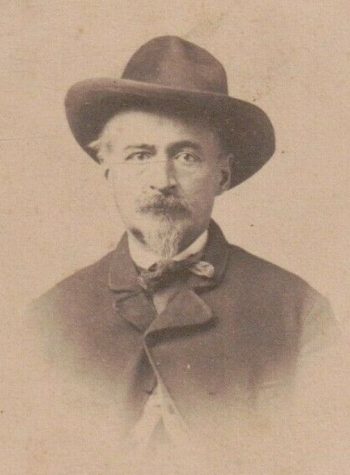
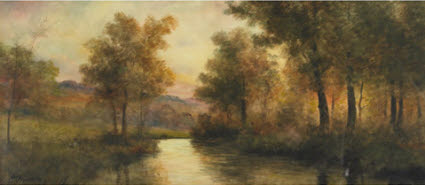
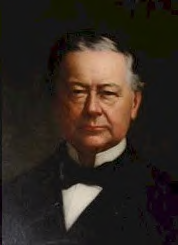
LOW, ABIEL ABBOTT (1811-1893). Businessman and president of New York Chamber of Commerce. Born in Salem, Massachusetts, Low, a businessman and clipper ship owner, became a staunch defender of the Union during the Civil War. Most of his wealth came from the China trade as an importer of porcelain, silk, and teas, beginning with his first trip there as part of his family’s business in 1833. By 1850, with a large fortune, he built a shipping establishment in the vicinity of what is now South Street Seaport in Manhattan.
During the Civil War, Low was treasurer of the New York Union Defense Committee which raised money to outfit regiments. In addition, as a director of the New York Bank of Finance, he was a financial supporter of the Union. After his election as president of the New York Chamber of Commerce, he was instrumental in organizing opposition to Great Britain’s support of Confederate cruisers, having lost two of his ships, the Jacob Bell and the Contest, when they were burned by Rebel raiders. It is said that he was a major force in dissuading the French from supplying the Confederacy with warships.
Low was among the organizers and committee chairs who participated in the very successful Sanitary Fair held at the Academy of Music in Brooklyn beginning on February 22, 1864, and headed by his wife, Anne D. B. Low (see), and Mary Stranahan (see). Low, who headed the General Committee and the Executive Gentlemen’s Committee, attended the planning session on December 19, 1863, pledged $2,500 and encouraged others to follow his lead. At the event, women, dressed in Pilgrim attire, served refreshments, a variety of patriotic exhibits were on display, and great sums were raised for the Union.
After the Civil War, Low was an investor in the Atlantic Cable, the Chesapeake and Ohio Railroad, and Virginia iron foundries. A philanthropist, he was president of the Brooklyn Female Academy in 1858, which later became the Packer Collegiate Institute, and served on its board until his death. He was the father of Seth Low, a mayor of Brooklyn, president of Columbia University and mayor of New York City. Seth Low used money from his inheritance to build the Low Memorial Library at Columbia University in his father’s honor in 1895. Section 93, lot 127.
LOW, ANNE D. B. (?-1890). Co-President, Brooklyn Sanitary Fair. Together with Mary Stranahan (see), Anne Low was co-president of the Brooklyn Sanitary Fair held in Brooklyn from February 22 through March 11, 1864. Organized by Brooklyn churches, the purpose of the event was to raise money for Union soldiers and to minister to their health needs. The event was held at the Academy of Music and auxiliary buildings were used as art galleries, exhibition halls and kitchens. At the close of business, $300,000 was donated to the National Sanitary Commission and applied to the relief of soldiers. Dr. Bellows, the President of the Commission, wrote, “Brooklyn has henceforth declared her independence of New York. She has indicated her right and power to lead.” Low is interred with her husband, Abiel Abbott Low (see), and is the mother of Seth Low, a mayor of Brooklyn, president of Columbia University, and mayor of Greater New York. She succumbed to heart disease. Section 93, lot 127.
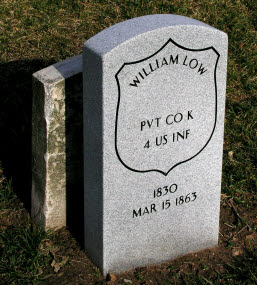
LOW, WILLIAM (1830-1863). Rank unknown, 4th Infantry, United States Army, Company K. Low served in the 4th Infantry of the United States Army. The details of his service are not known. He lived in Manhattan at 426 West 16th Street. He died of consumption. Section 115, lot 13536 (Soldiers’ Lot).
LOWBER, DANIEL ALFRED (1843-1902). Captain, 37th Wisconsin Infantry, Company A; private, 13th Independent Battery, Wisconsin Light Artillery. Born in New York, he was a resident of Columbus, Wisconsin, when he enlisted as a private on November 16, 1863, and mustered into the 13th Independent Battery of the Wisconsin Light Artillery that same day. On March 7, 1864, he transferred into the 37th Wisconsin with a promotion to second lieutenant, and was wounded at Petersburg, Virginia, on June 18. He rose to first lieutenant on July 28, and became a captain on September 27, 1864. He was wounded again at Petersburg on April 2, 1865, and mustered out with his company on July 27 of that year.
The Virginia Polytechnic Institute has Lowber’s Civil War diary in its collection. The journal dating from July 25- December 31, 1864, began the day after the Battle of the Crater, Virginia, and noted that when he took command, only 18 men were fit for duty. During the next five months, he recorded his administrative duties, living conditions, picket duty, trading papers with a Confederate soldier, news of Sheridan’s victories in the Shenandoah Valley, the regiment’s vote tally for the 1864 presidential election, and the Battle of Peebles’ Farm (Poplar Springs Church), Virginia.
After the Civil War, Lowber lived in Waupun, Wisconsin, through 1880 where he was employed as an operator of a variety store, news dealer, confectioner and miner. By the turn of the century, he returned to New York and worked as a railroad supplier. In 1900, he was the commander of the George C. Strong Post #534 of the G.A.R. As per his obituary in the Brooklyn Daily Eagle, he lived in Brooklyn for twenty-two years and was president of the Lowber Hardware Company in Manhattan. His obituary stated that he was one of the G.A.R. veterans who formed the Presidential escort on Pennsylvania Avenue in Washington, D.C., in March 1901. At that time, the newspaper reported that Lowber remembered his earlier experience on Pennsylvania Avenue in 1865 when he participated in the grand review of Union troops marking the close of the Civil War. He reminisced that his company was at the head of the marching troops of the Ninth Corps; at age 21, he was one of the very young captains in the Army. He last lived at 246 Decatur Street in Brooklyn. His death was caused by angina pectoris. Section 21, lot 5488.

LOWELL, CHARLES A. (1838-1862). Private, 11th Maine Infantry, Company D. A resident of Springfield, Massachusetts, he enlisted as a private on October 19, 1861, and mustered into the 11th Maine Infantry the same day. He died on July 17, 1862, at Long Island College Hospital in Brooklyn of typhoid fever contracted while in the service. A marble Veterans Administration stone was ordered for him early in the 20th century. Section 115, lot 13536 (Soldiers’ Lot), grave 77.
LOWERY, THOMAS (1838-1892). Private, 48th New York Infantry, Company F. A native of Ireland, he enlisted as a private at Brooklyn on August 25, 1862, and mustered into the 48th that day. He was wounded at Fort Wagner, South Carolina, on July 18, 1863, and was discharged for wounds on November 25 of that year. As per his obituary in the New York Herald, he was a Freemason. Lowery last resided on West 18th Street in Manhattan. He died from cirrhosis. Section 191, lot 23471.
LOWRY, PHILIP W. (1845-1866). Ensign, United States Navy. After enlisting as a midshipman in the Navy on September 22, 1859, Lowry rose to ensign on September 16, 1862. He died at Fort Hamilton, New York, from tuberculosis. Section 59, lot 11733, grave 16.
LOWTON, JOHN (1845-1929). Corporal, 9th New Jersey Infantry, Company B. Originally from England, Lowton immigrated to the United States in 1848. During the Civil War, he enlisted as a private on October 8, 1861, and mustered into the 9th New Jersey Infantry that same day. He re-enlisted on January 18, 1864, was promoted to corporal on July 1, 1864, and mustered out on July 12, 1865, at Greensboro, North Carolina. The 1890 Veterans Census confirms his Civil War service. As per the 1891 Brooklyn Directory, Lowton was a confectioner; he is listed as working in the gas meter business in the 1906 Brooklyn Directory. In 1892, he applied for and received an invalid pension, certificate 1,017,078. According to the 1920 census, he had no mortgage on his home. He last lived at 415 51st Street in Brooklyn. Section 131, lot 34399.
LOZIER, ABRAHAM WITTON (1838-1896). Surgeon with the Sanitary Commission. Born in New York City, he graduated from the New York City College in 1859 and then received his medical degree from the College of Physicians and Surgeons. During the Civil War, he was a surgeon for the United States Sanitary Commission, an agency that devoted itself to inspecting field camps and hospitals to upgrade the hygienic conditions of Union soldiers. According to his obituary in The New York Times, Lozier was detailed to the Army of the Potomac and also played a part in the New York City Draft Riots in July 1863, at which time he offered shelter to black victims and cared for them at his home and in local hospitals.
The New York City Directory for 1877 lists Lozier as a physician. A proponent of women’s rights, he supported women’s suffrage and medical education. His mother, Clementine Lozier (see), who is also buried at Green-Wood, was a founder of the New-York Medical College for Women; he held a professorship in histology and physiology there. At the time of his death, he was the dean of the New-York Medical College and Hospital for Women. His obituary noted that he was a participant in temperance work and Sunday school activities. After his retirement in 1888, he was interested in real estate on Manhattan’s West Side. As per his obituary in the New York Herald, members of the Delta Kappa Epsilon fraternity were invited to attend his funeral. He last resided at the Hotel Winthrop at 1288 Seventh Avenue in Manhattan. He succumbed to heart disease. Section 152, lot 19173.
LOZIER, CLEMENCE SOPHIA HARNED (1813-1888). Homeopathic physician, women’s rights activist, abolitionist, and reformer. Lozier, the youngest of thirteen children, was born in Plainfield, New Jersey, to a Quaker mother and a father who was a farmer. Educated at the Plainfield Academy, her first name was pronounced “clemency.” Her mother was the neighborhood “medicine woman” who practiced the healing techniques that she learned from Native Americans in Virginia. Orphaned at the age of eleven, Clemence married Abraham Witton Lozier, a carpenter and builder in New York City, in 1828. When her husband’s health failed, she opened a girls’ school in their home on West 10th Street to support her family and maintained that school for eleven years. Of the five or seven children that she bore, only one, Abraham Lozier (see) survived infancy. Influenced by her brother, who was a doctor, she studied medical books, then taught her pupils anatomy, physiology and hygiene, topics that were considered inappropriate for girls at that time. Her husband died in 1837, and she soon became a “visitor” for the New York Female Moral Reform Society, which campaigned to end prostitution and to reclaim the fallen. She left New York City in 1844, for Albany, New York, and married again shortly thereafter. This marriage, however, was an unhappy one, and she sought a divorce, an unconventional act at that time; it was granted in 1861.
After applying to several medical schools, only to be rejected because of her gender, she attended lectures at the Central New York College of Rochester in 1849, then enrolled at the Syracuse Eclectic College from which she graduated with highest honors in 1853. Returning to New York City to specialize in obstetrics and gynecology, she offered women of the time a rare opportunity to be treated by a physician of the same gender. Female patients sought her out and she offered lectures in her home on medical topics of interest to them. She excelled in obstetrics and general surgery, and her income surpassed that of all except a few physicians. (As per her obituary in The New York Times, she earned more than $20,000 a year.) Knowing that women were hissed at and verbally abused by male students, she planned a school for women. On April 14, 1863, with the help of her friend Elizabeth Cady Stanton, she founded the first medical school for women in New York State, the New York Medical College and Hospital for Women at 724 Broadway; there were eight faculty (four men and four women) and seven students. During its first year of operation she personally guaranteed all of its expenses. The hospital was associated with a nearby homeopathic hospital, New York Medical College, established in 1860. Homeopathic medicine emphasizes among its tenets moderation in medicinal dosage, exercise, a healthful diet, fresh air and rest in treating illness.
Lozier’s interests extended to other areas of civil rights. An advocate for African-Americans and abolitionist affiliated with the Anti-Slavery Society, she hosted anti-slavery meetings in her house and during racial disturbances in 1863, offered her home as a safe haven to those fleeing violence. Purportedly, African-Americans became interested in homeopathic medicine as a result of her work. (Susan Smith McKinney Stewart, the first African-American female physician in New York State and the third in the nation, graduated from New York Medical College for Women in 1870 with the highest grade in the class.) Lozier toured Europe after the Civil War, studying hospital construction and administration, then returned to reorganize her school and hospital, serving as dean and professor of gynecology and obstetrics until her death. Over her lifetime, she contributed $25,000 to the institution without accepting any payment. The school was a great success, graduating 200 women physicians during her tenure, including her son’s first and second wives. Her school and hospital became a part of the New York Medical College of the Flower and Fifth Avenue Hospitals in 1918.
She was the first woman to present a paper to the New York State Homeopathic Society and authored books for women, including Child-birth Made Easy (1870). Her advocacy extended to the woman’s suffrage movement in which she served as president of the National Woman’s Suffrage Association (1877-1878) and the New York City Woman Suffrage Society (1873-1886). Lozier was a leader in Sorosis (the New York women’s club), National Working Women’s League, was president of the Moral Education Society of New York and the local Woman’s Christian Temperance Society, and was vice president of the Universal Peace Union. Her home, which had earlier hosted women’s health lectures and anti-slavery activities, became a meeting place for advocates of prison reform, international arbitration, and Indian rights. Her funeral was attended by more than forty female doctors, all of whom had graduated from her school. Elizabeth Cady Stanton eulogized her with this statement, “As a mother, wife, physician, friend, and reformer we cannot too highly exalt her virtues.” Her son said, “Perhaps no woman of her age has accomplished so much in so many different directions for women. No one ever inspired women more with faith in themselves, nor ever a readier hand worked with a readier heart for mankind.” An article about her funeral in The New York Times on April 30, 1888, reported that among the groups represented at her funeral were members of the New-York Abolitionists’ Reunion. Matthew Brady’s photograph of her, Mrs. Dr. Clemence Lozier, is included in his Photographs of Civil War-Era Personalities and Scenes in the United States National Archives (Identifier 111-B-1691). She last lived at 103 West 48th Street in Manhattan. Section 152, lot 19173.
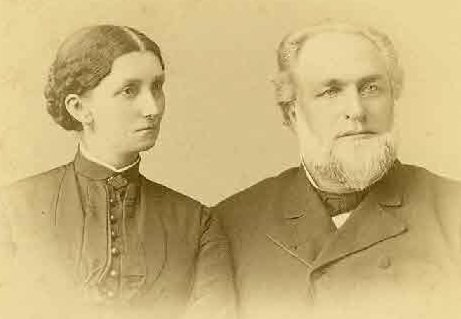
LUCAS, JAMES BOYD (1838-1911). First lieutenant, 211th Pennsylvania Volunteer Infantry, Company E. Born in Dunkard County, Pennsylvania, he was a Methodist minister living there as per the census of 1860. Lucas was ordained in 1860 at Pittsburgh. During the Civil War, he enlisted as a private on August 22, 1864, at Greensburg, Pennsylvania, and was promoted to first lieutenant and commissioned into the 211th Pennsylvania on September 12. He was ill and hospitalized with typhoid fever from November 19, 1864 until he mustered out on February 17, 1865, at Point of Rocks, Virginia. His wartime disease left him with a limp and weakened left arm. In 1866, his application for invalid pension was approved, certificate 168,233. Lucas’s ministry took him to many states beginning in Pennsylvania and then to West Virginia from 1874-1877 and Ohio from 1877-1885. In 1884, he became affiliated as a Methodist Episcopal minister. Lucas’s ministry took him to Michigan from 1885-1888, Illinois in 1890-1895; and to Texas from 1905-1908. He was widowed and retired in 1910 when he lived with his younger son, Charles Walter Lucas, at 1470 Avenue G in Brooklyn. He died at Methodist Episcopal Hospital on October 16, 1911, and was interred on October 19 in a temporary receiving tomb at Green-Wood. When the remains were unclaimed as of December 15, 1914, a note was made that “we cannot collect this bill.” Lucas was buried on February 25, 1915, in a single grave area set aside for the burial of unclaimed bodies. Section 206, lot 27367, grave 64.
LUCKEY, CORNELIUS B. (1843-1868). Private, 84th New York (14th Brooklyn) Infantry, Company H; 5th New York Veteran Infantry, Company K. On August 14, 1862, Luckey, a Brooklynite, enlisted there as a private, and mustered into the 14th the same day. On June 2, 1864, he was transferred into Company K, 5th New York Veteran Infantry, where he served until he mustered out in 1865. As per the Brooklyn Directories for 1864 and 1866, he worked as a mason. He joined the G.A.R. Rankin Post #10 in 1867. It is likely that he was the brother of George (see). His last residence was at 59 Wyckoff Street, Brooklyn. His death was caused by heart disease. Section 105, lot 7234.
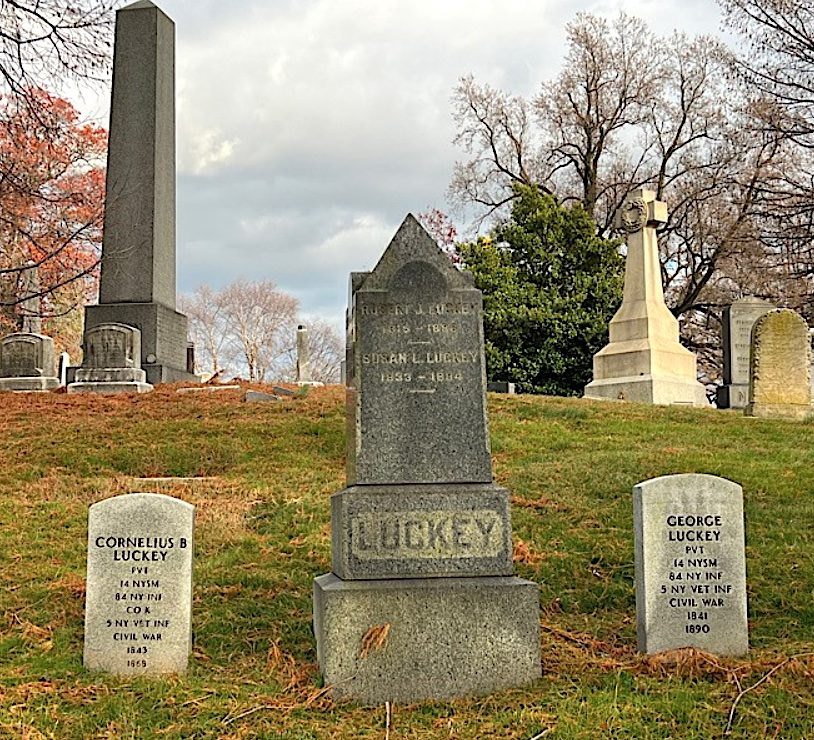
LUCKEY, GEORGE (1841-1890). Private, 84th New York (14th Brooklyn) Infantry, Company H; 5th New York Veteran Infantry, Company K. On August 21, 1862, he enlisted at Brooklyn and mustered into the 14th Brooklyn the same day. He transferred into the 5th Veterans on June 2, 1864. It appears that Cornelius (see) was his brother. His death is listed as from “morbus cordis, valvelorum, eplepsia, dementia.” Section 105, lot 7234.

LUCKEY (or LACKEY), JOHN E. (1837-1909). Private, 14th New York Infantry, Company H. Luckey, a native of Brooklyn, served in Company H of the 14th New York. The dates of his enlistment and discharge are not available. He last lived at 22 Grand Street in Jamaica, Queens. Heart disease caused his death. Section 117, lot 196, grave 7.
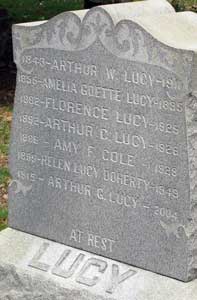
LUCY, ARTHUR W. (1843-1911). Private, 50th Massachusetts Infantry, Company F. A student who resided at Bradford, Massachusetts, Lucy enlisted as a private on August 18, 1862, mustered into the 50th Massachusetts on September 19, and mustered out of service on August 24, 1863, at Wenham, Massachusetts. In 1890, his application for an invalid pension was granted, certificate 811,808. His last residence was 545 59th Street, Brooklyn. He succumbed to apoplexy. Section 131, lot 33209.
LUDLAM, ISAAC (1840-1910). Private, 71st Regiment, New York State Militia, Company A. A native of New York City, he enlisted in 1861 and served for three months with Company A of the 71st New York State Militia. His last residence was in Rochelle Park, New Jersey. He succumbed to cirrhosis of the liver. Section 156, lot 16723.
LUDLAM, JOSEPH (1840-1929). Captain, 28th New York Infantry, Company I. Born in Stafford, Virginia, he enlisted at Brooklyn as a captain on July 10, 1864, was commissioned into the 28th New York on August 29, and mustered out on November 13 of that year at New York City. In 1904, he applied for and received an invalid pension, certificate 1,099,303. As per his obituaries in the Brooklyn Daily Eagle and the Brooklyn Standard Union, he was a member of the McPherson-Doane Post #499 of the G.A.R. and the Royal Arcanum; members of both organizations were invited to attend his funeral. He last lived with his daughter in Stafford, Virginia. His death was caused by pulmonary pneumonia. Section 175, lot 27522.